

Cover Letter Vs. LinkedIn-Which One Should You Choose?
People often wonder, should I take the time to write a cover letter or not? Do I need a LinkedIn presence? Do I need both? This article reveals the advantages of each and how to master their use in your job search.
The Most Effective Introduction for Your Job Hunt
A job application has many moving parts, from uploading a resume to answering pre-interview questions. When thinking of the different possibilities after clicking the ‘submit’ button, including a cover letter and creating a LinkedIn profile are great ways to express your interest in the company you want to pursue. When looking at a cover letter and LinkedIn profile, sometimes it’s easier to choose one. Which one would benefit you the most? With each one having its unique benefits and uses, it’s essential to know what they will bring.
The Benefits of Using a Cover Letter
Incorporating a cover letter into your job application adds more benefits than you think. Surprisingly, many candidates choose not to include a cover letter because they believe it won’t be a deal-breaker. However, putting in a little extra work can pay off during your job hunt. When you write your resume, you focus solely on the facts at hand, your accomplishments, and the metrics that set you apart. You can focus more on your personality and who you are on the cover letter. The overall idea of writing a cover letter is to be specific to the position you’re applying for and explain how the role aligns with your personal and professional vision.
Employers See Who Puts in the Extra Work
It’s easy to overlook the benefits of writing a cover letter for the position you’re applying for. However, writing a custom letter for the hiring manager may set you apart from the competition. Think of it from the employer’s point of view; if they were down to two candidates, but one chose to write a well-thought-out letter, and the other didn’t, who do you think may have the edge? Personalize the cover letter with the name of the hiring manager or recruiter within the company because that will display to them the additional effort and initiative you put into the interviewing process. Employers want to hire candidates who genuinely are interested in their job openings.
Be Authentic
When in an interview, employers want to know who you are as a professional and as a person. Do you enjoy specific hobbies? Are you a vigilante volunteer in your spare time? Do you enjoy having a work/life balance? Take time to incorporate a few sentences in your cover letter to explain who you are on a personal level. Because resumes are about the facts, let the writing style and tone of your cover letter have a more personal feel. Being your genuine self is more important than regurgitating what the job description states.
Do Your Research
Aside from a resume, a cover letter lets you show off your knowledge of the company you’re applying to. Use company-specific examples of what made you investigate them in the first place and how that aligns with your values. This approach will set you apart from the influx of applications recruiters receive from LinkedIn, Indeed, Zip Recruiter, etc. Recruiters don’t want to review an application where the candidate just went down the list and made the one-click application without looking into the company. Employers value loyalty, and this tactic will help set you apart as a candidate.
The Benefits of Using a LinkedIn Profile
While a cover letter strengthens your application, creating a LinkedIn profile boosts your online presence to prospective hiring managers. LinkedIn hosts more than 600 million professional profiles and offers a nearly unlimited supply of network connections and job opportunities. So, whether your goal is to find a new role, connect with professionals, or uplift your professional presence, LinkedIn is essential for today’s ever-changing market.
Recruiters Can Find You
A platform called LinkedIn Recruiter is an all-encompassing hiring platform that helps talent professionals find, source, connect with, and manage potential new hires. When you receive an InMail message from a recruiter, they likely found you through the LinkedIn Recruiter database.
LinkedIn offers a premium account that allows people who apply through their posts to see where they stand among applications; for example, their LinkedIn profile could rank them in the top 5%, 10%, 20%, and 50% based on the number of applicants.
Sometimes, the job posting will show who posted it; this allows the candidate to send an InMail message directly to that recruiter, bypassing the need for an ATS scanner. Although LinkedIn Premium is an investment, it streamlines the application process and gives you some insight you can use. For example, if you apply for specific positions where you have the experience, but your profile shows you are ranking comparatively low, you can decide to add relevant skills to your profile that the job requires. You can ensure that you aren’t shorting yourself by omitting skills the employer desires.
Tips to Boost Your LinkedIn Presence
- Showcase your accomplishments under each position on your profile.
- Maximize the skills section by adding 20 to 50 relevant hard skills in your wheelhouse.
- Add a custom banner photo showing your target industry and personality.
- Write an eye-popping headline that displays your specialties.
- Fill in your education, volunteer work, awards, and published work.
Choose Your Tools
After reviewing the benefits of a cover letter versus a LinkedIn profile, you’ve probably realized that they have different uses. While a cover letter helps enhance your application, a LinkedIn profile establishes an online presence that expands your reach to hiring managers who may only be searching through that platform. Not all employers use every job board to post a job; some may exclusively use LinkedIn, Indeed, or an industry niche board.
Leverage LinkedIn for Networking and Presence
Creating a LinkedIn profile that shows your skills will boost your chances of recruiters knocking on your door. If you haven’t investigated creating a LinkedIn profile yet, there is no better time to start than now. Use your profile to connect with people in your network, get found for new, exciting opportunities, and establish a unique identity for yourself.
Use a Cover Letter to Align with Specifics
Leveraging a cover letter allows you to express your interests more personally; it’s a flexible, precise tool to connect with the company and illustrate why you are the best fit for what they are looking for. Your letter can be “the thing” that helps the hiring manager recognize your name and enables you to stand out from everyone else who applied.
About Equiliem
Equiliem ( www.equiliem.com ) believes in empowering success. It’s our job to cultivate relationships that connect people and employers in a way that is inclusive, intelligent, and allows both to thrive.
Across the U.S., leading companies in healthcare, government, light industrial manufacturing, professional services, and energy rely on us for their workforce solutions. Our recruiting and HR services include contract and direct hire staffing, Payrolling/EOR, Independent Contractor Compliance, and Managed Services.
Since 1995, we’ve helped shape our industry. Today, we continue to research, ask questions, and continuously enhance the candidate journey and client experience.
Do this before you use LinkedIn "Easy Apply" to job search
Mogul Millennial Staff
<div class="ap-custom-wrapper"></div> <!--ap-custom-wrapper--> <div class="ap-custom-wrapper"></div> <!--ap-custom-wrapper--> <div class="ap-custom-wrapper"></div> <!--ap-custom-wrapper-->
More posts by Mogul Millennial Staff.
If you’re on the job hunt, one of the easiest ways to submit an application is through LinkedIn.
There are hundreds of thousands of companies that have LinkedIn pages, and many of them use LinkedIn as a recruiting tool. If a company wants to post jobs on LinkedIn they can either A) Post a link to the job that they are hiring for and this link will redirect the user to their own site or to their job posting site, or B) They can collect applications and recruit eager applicants directly through LinkedIn (no middle man involved).
For many companies, the second option is the easiest and simplest way to recruit new employees. This second option allows LinkedIn users to easily apply for jobs with just a few clicks of a button.
Literally ya’ll.
That’s right, with the second option Easy Apply , LinkedIn users don’t have to spend all of their time filling out applications that can take forever and a day.
Finding jobs with the Easy Apply feature is very simple too. Once you are logged into your LinkedIn account, click “Jobs” at the top of the page and then search for the job you want. After that, all of the jobs that match your search criteria will load. Any job that has the LinkedIn symbol with “Easy Apply” next to it are jobs with the Easy Apply feature.

I have personally used the Easy Apply feature as an applicant and I have to admit, it’s super easy and user friendly .
Here are the top 4 things you can do to make sure your application is Easy Apply ready and stands out among the other applicants.
1. Make sure your LinkedIn profile is 100% complete BEFORE you apply
The first thing a recruiter will do after they receive your Easy Apply app is look at your LinkedIn profile. Before you start applying to jobs, you need to make sure your profile is up to date and accurate AF. In other words, your profile picture should be on point, and all of your jobs and relevant skills should be listed with keyword-rich descriptions.
2. Go ahead and customize your resume
Although including your resume is not mandatory for some Easy Apply jobs, attaching a customized resume will help you stand out from the other Easy Apply applicants. Just like you would do with any other job you are applying to, you should ALWAYS customize your resume. It doesn’t matter if you are applying for the job on the company’s website, Indeed, or through LinkedIn, customization is key.
3. Don’t forget the cover letter
If you REALLLLLY want to boss things up, you should even write and include a customized cover letter for the job you are applying to. Since Easy Apply often gives you the option to upload one attachment, include your cover letter in the same PDF file as your resume so that it’s a single document to upload.
4. Be the follow-up King (or Queen)
For most companies, they get hundreds of applicants after posting a single job, so why not do as much as you can to stand out? For some Easy Apply job postings, you can see who posted the job or who is the recruiter. If not, just do your research on LinkedIn, and I’m sure you can find the right person to contact.
After you apply, follow up with a nice, thoughtful email (or in-mail), letting them know that you have applied and that you are eager to discuss the position with them.
Tweet us and let us know how you like Easy Apply! Good luck on your job search!
Subscribe to DEEZZZMogul Millennial
Get the latest posts delivered right to your inbox
Subscribe to Mogul Millennial
Stay up to date! Get all the latest & greatest posts delivered straight to your inbox
Writing a LinkedIn cover letter
LinkedIn is a popular professional social network that allows employers to post open positions and receive applications. In some cases, these applications require a cover letter submitted directly through the platform. While a LinkedIn cover letter is similar to a standard one, being on the platform allows you to leverage certain personalization features to impress recruiters and give you the best chance of landing the job you want.
How to make a cover letter on LinkedIn
When it comes to cover letter examples , LinkedIn doesn’t supply any. The platform has its own set of rules and expectations, and it's important that you follow them. Here are a few things you need to know about navigating the process and making sure your professionalism shines through.
Search for a job post
LinkedIn makes it easy for job hunters to search for roles they’d like to apply for. From your profile page, simply click on the “Jobs” icon at the top of the page. On the “Jobs” page, you’ll be able to see the top opportunities LinkedIn recommends based on the qualifications listed in your profile.
The site will also provide a plethora of other suggestions, including keywords to search, companies hiring for your skills, and jobs where you’re likely to be a top applicant.
Apply through the “Apply” or “Easy Apply” functions
When you choose a particular role, LinkedIn will show you a detailed job description, as well as the posting date, number of applicants, and current employees you may know. There will also be an option to either apply for the position or save the posting to come back to it later.
To apply for the position, click the “Apply” button. In some cases, this button will take you to the employer’s website to submit an application through their online system. If there’s an “Easy Apply” button, clicking it will usually take you to an on-platform application.
There, you’ll be asked to upload your resume as a file attachment, fill in your personal details, and possibly answer a few questions. There may also be a message box where you can type your cover letter.
Personalize your cover letter
Applying on LinkedIn provides added benefits for applicants. In many cases, you’ll have the unique ability to see who posted the job and what their role is. There’s often a button next to this feature that allows you to message that person to ask questions about the posting.
The bottom of the job description also usually includes a link to the company page. From there, you can sometimes see the profiles of employees in key roles.
You can also click the “People” tab on an employer’s LinkedIn page to search for the name of a hiring manager. This will help you personalize the cover letter templates you use so you can address them to the right person instead of simply including a generic greeting.
Highlight relevant skills and experience
Another benefit of using LinkedIn to apply is that employers can see the relevant skills and experience listed in your profile. Consequently, they’ll be able to cross-reference the skills you include in your cover letter and resume.
Though many resume articles may tell you that this information is sufficient for your letter, keep in mind that LinkedIn doesn’t always provide adequate space to discuss your skills in context. Your profile won’t be able to align those skills with the employer’s posted job description.
For that reason, it’s important to connect the dots for the employer in your LinkedIn cover letter, explaining how your background, skills, and experience have set you up for success and make you the best candidate for the position.
This tactic is crucial for differentiating yourself from other applicants on LinkedIn and is especially important for roles where the platform indicates that there are already many applicants.
Include a call to action
This is one way writing a LinkedIn cover letter aligns with the conventional wisdom found in many cover letter articles .
Make sure to end your cover letter with a clear prompt for the person reading it to take the next step in the hiring process. Reiterate your enthusiasm and invite them to view any materials or portfolios you’ve included on your profile or application.
Tell the hiring manager you’d love to set up an interview or a time to talk further about how you can help the company reach its goals. Let them know you’re available to chat through LinkedIn and provide another contact method in case they prefer an alternative venue.
Proofread and edit
LinkedIn makes writing a cover letter quite easy. That said, it’s important to remember that while social media platforms can seem casual, that doesn’t mean you should take your cover letter and application any less seriously.
To appear as professional as possible, make it a point to proofread and edit your LinkedIn cover letter and resume to confirm that they’re error-free. If you’ve used a cover letter or resume template , alter parts of it to reflect your unique skills and background.
Send your application
Once everything is complete, submit your job application on LinkedIn by clicking the appropriate button. You also have the option to save your application so you can finish and submit it later.
Remember that employers can’t see your application until it’s submitted. If you forget to take this step, you won’t be in the running for the position you’re interested in.
Expert Tip:
Consider using a typing assistant or online proofreading tool to help you edit your cover letter before you send it. That way, you can spot errors and make changes inside the LinkedIn message box as you type, so you won’t have to worry about coming across as unprofessional.
To-do’s after sending your application
You may wonder what happens next once your application package is in the employer’s hands. Unlike the company’s applicant tracking system (ATS) , which may or may not give updates about your application, you can track your applications on LinkedIn.
Simply navigate to the “Jobs” tab on your profile, click “My Jobs” on the left-hand side, and choose “Applications” to see the jobs you’ve applied for. You can also adjust your notification settings to receive job application updates via email or the LinkedIn app, including recruiter views or resume downloads.
If you want to continue your job hunt and submit another resume and cover letter , LinkedIn makes it easy. If requested or given room to do so, including a LinkedIn cover letter in each of those applications can go a long way toward helping you stand out amongst a sea of applicants.
Finally, if you haven’t heard back from the company within one to two weeks, consider sending a follow-up message via LinkedIn.
Remind the hiring manager or recruiter of your qualifications, highlight why you’re a great fit for the role, and let them know you’re enthusiastic about the possibility of an interview to discuss how you can be of value to the company.
“While social media platforms can seem casual, that doesn’t mean you should take your cover letter and application any less seriously.”
Use LinkedIn to your advantage in your search for the perfect role
As easy as it is to apply for a job on LinkedIn, it’s still important to ensure that your cover letter and application come across as poised and professional.
Before applying, familiarize yourself with the platform functions and use them to research the recruiter or hiring manager’s name. When you write your cover letter, personalize your greeting using that name instead of going with something more generic.
Additionally, give context to the experience and skills you’ve listed and explain why you’re a good fit for the role, using your LinkedIn profile as a resume example of sorts. Include a call to action at the end, and don’t forget to proofread your letter before sending it off.
If you’re coming up blank trying to compose your letter, consider using a LinkedIn cover letter example as your guide.
Reviewing cover letter and resume examples can help you determine the appropriate structure and maintain a professional tone throughout. With the right resources, you can draft a standout cover letter that gets your application moved to the top of the digital stack.
Get ahead of the competition
Make your job applications stand-out from other candidates.

The Best Tips on How to Start a Cover Letter

How to End a Cover Letter With Confidence

The Importance of a Good Cover Letter Structure
How to Use LinkedIn Easy Apply to Get Interviews
By Biron Clark
Published: November 13, 2023

Biron Clark
Writer & Career Coach
The brutal truth of job searching is this:
If you want to find a job fast, you need to apply for a high number of jobs.
Companies post job openings and then change their mind. Or they change the requirements. Or they decide to “hold off” for a month, which turns into three months or forever.
The bottom line is: There are a million things that can go wrong, with no relation to your skill or how much you prepare to ace the interview . So you need to apply to a lot of employers if you want to get hired quickly.
But how can we send out a high volume of applications quickly and easily? That’s where LinkedIn Easy Apply comes in.
Using this specific feature when applying for jobs on LinkedIn is one of the best ways to get a high number of applications out quickly.
Here’s how…
What is LinkedIn Easy Apply
LinkedIn Easy Apply is a one-click application feature on a select number of job postings featured on LinkedIn.com. We estimate that between 35-45% of jobs feature the “Easy Apply” option on LinkedIn, depending on industry and position. When an employer decides to allow Easy Apply, you can submit your LinkedIn profile in response to a job ad.
This can save you tremendous time in your job search, because unlike most job search websites , you won’t need to fill in ANY personal details. You just attach your resume, click submit, and move on.

Should You Send a Cover Letter with LinkedIn Easy Apply?
It is not necessary to submit a cover letter when using LinkedIn Easy Apply. Unless you know the hiring manager’s name or know something specific about the position that you’d like to address, our advice is to skip the cover letter so you can apply for more jobs. While some employers appreciate a cover letter, it usually won’t be a deal-breaker for employers who allow LinkedIn Easy Apply.
They’re going to be looking at your profile when they see your submission, not checking for a cover letter.
Now that you know what LinkedIn Easy Apply is, let’s talk about why it’s so effective and how you can start using it. Here’s why we recommend using LinkedIn Easy Apply…
LinkedIn Easy Apply is the Best Way to Send Out a Lot of Applications to High-Quality Companies
Job searching isn’t all about volume. You should be networking , doing thorough research to find companies to apply to, etc.
But volume does help in your job hunt, for reasons mentioned in the intro of this article.
And LinkedIn Easy Apply is the best way to add that volume to your job hunt… without having to write a cover letter, fill in pages and pages of online info, etc.
The companies that post jobs on LinkedIn tend to be high-quality and reputable, too, and since LinkedIn is such a large job search site, you can do almost all of your “volume” applying through LinkedIn if you want. (Note: you should still be networking and doing more targeted methods like emailing companies directly, too. I’m just suggesting that LinkedIn can be the only job board you use).
How to Use LinkedIn “Easy Apply” to Find Jobs…
Now let’s look at how to actually use LinkedIn Easy Apply to get your info in front of companies.
1. Log into LinkedIn
This is pretty self-explanatory, but you need to have a LinkedIn account to do this, and you need to put detailed info on it, since that’s what employers see when you apply.
If you need help with setting up and optimizing your LinkedIn, here’s what to put on your profile .
2. Enter a job title or job keywords into the search bar
Next, enter basic search terms into LinkedIn’s search box at the top of the screen.
You could search for a job title like, “Software Engineer” or “Sales Manager”. That’s how I recommend starting.
3. Use LinkedIn’s job search filters to narrow your search
After you type in your basic search, you’ll want to use LinkedIn’s filters to narrow your search further – by location, industry, etc.
Then you’ll start seeing relevant job postings in your city or state. After that, start opening jobs that look interesting. This is where we’re going to look for the LinkedIn Easy Apply button…
4. Look for the Easy Apply button on LinkedIn job postings
Here’s what the “Easy Apply” button will look like when available:

As mentioned earlier, you’ll see this on around 35-45% of LinkedIn job postings. So it won’t be there every time, but you should see that button pretty often in most industries.
5. Start applying
Now you’re ready to start applying. Click the “Easy Apply” button, attach your resume (after quickly tailoring it for the job description ), and submit your info! It’s that easy.
Note: If you see relevant job postings that don’t feature the Easy Apply option, it still may be worth applying. Clicking the button when it doesn’t say “Easy Apply” usually takes you to the company website. If their application process looks straight forward and easy, then it’s still worth applying directly.
6. Build a habit of applying for jobs on LinkedIn each day
Try to spend one hour in total the first few days. Before discovering this method I probably spent half that much time on a single application online… for a company that didn’t even get back to me!
So you’ll be able to get a lot more applications out if you begin your search on LinkedIn and use the Easy Apply button as often as possible.
Common Questions about LinkedIn Easy Apply
What about finding a job through my network? I’ve been told that’s the most effective way.
You’re right. Networking is the fastest way to get a job potentially.
So if you have a connection to a company through a colleague, it’s always better to use that.
DO NOT send out a generic LinkedIn Easy Apply application if you have a more personalized method to get in touch with a company.
However, for all those times you don’t know the hiring manager or have anyone in your network who does, applying for the job on LinkedIn is a great approach. That’s what this article is about.
Do I need to tailor my resume?
I’m a big believer in tailoring your resume. It works for sure. Even though this method is all about volume and speed, I’d say you should still tailor your resume for the job description, or at least for the general type of job you’re applying for.
So, let’s say you want a software sales job… At minimum, you should tailor your resume work history and other info for that general type of job. Optimize everything to show how you’ll be an asset to them in a software sales position.
Then, if you also want to apply for jobs in software project management, that’s another resume tailored to that type of role. That’s the minimum of what you should be doing.
I wrote this step-by-step guide on how to tailor your resume for any job . You might want to check it out if you need help with this step.
Isn’t this spam?
Not if you’re qualified for the job! Why does a company care if you applied to many positions within an hour of your time? In fact it’s none of their business. Each company is receiving one single application from you. I don’t see how that can be seen as spam on their end.
What about quality? This seems all about quantity.
You can choose how selective to be and how much time to spend researching each company. My goal is to show you how to find a job fast, and without the stress and frustration. There’s no rule saying you need to apply for each job in 4 minutes or less though. Take your time and do more research for each company if you’d like!
Now you know how to save time and send out more applications by applying for jobs on LinkedIn and using Easy Apply.
If you have a question about any of this, leave a comment below.

About the Author
Read more articles by Biron Clark
23 thoughts on “How to Use LinkedIn Easy Apply to Get Interviews”
Does it help to have a LI premium account when hiring managers are looking at your resume? I get a pop-up message implying it might help.
I’ve never paid for LinkedIn premium to be honest, and as a recruiter, I never cared if a job seeker has it. The only time I had a premium account was Sales Navigator, and that was to help me work as a recruiter, not to find a job. And in this case, my employer was paying for it. I don’t think you need it, to be honest.
Cover letters are great if you need to explain a specific situation… being unemployed 15 months… trying to completely change careers… etc.
I’m getting an error message when I try to use Easy Apply… states “try again”. No other info, FAQ etc. Have you seen this? If so, any suggestions on how fix this?
Probably just a temporary technical glitch. I’d try again in 1-2 days. I’m not sure beyond that. I might try logging out and back in, or trying on a different device, too. But those are just my best guesses.
Hey – is there an updated version ?
Unfortunately, no. We haven’t created a new tutorial for the newer version of LinkedIn yet.
I like this method. But I just did a search for job postings and hit the Apply button. I was then re-directed to either the company’s career page to apply or to a third-party vendor such as Workday just like the other job boards (Glassdoor, Indeed). Is it still better to submit your resume through LinkedIn rather than one of the other job boards?
Do you feel this still works with applicant tracking systems? I would think if you don’t tailor your resume to the keywords you are just going to sit in the system because it got graded too low
I’d do a bit of tailoring with this method now. Great point. Spend a few minutes making sure you’re mentioning keywords from the job description, etc.
Excellent tutorial! This is what I’ve been telling my friends and family to do all along… They always wonder how I find decent jobs so quickly, and your method is exactly what I’ve been doing for several years. It’s just nice to see someone besides myself finally advocate for this method. People want to look for super specialized jobs, when in many cases, they just need a job to get them through until they find that specialized position. Thanks again!
Biron, does it matter whether your resume is a .pdf or a .doc?
Great question.
As a recruiter, I always preferred getting it in Word format (.doc). Our recruitment agency would “stamp” our logo in the top corner, and then send it off to clients. And we could make an edit if needed (after speaking with you).
Advantages to a PDF, though:
Formatting will look the same on all devices, always. Cannot be edited. Revision history cannot be viewed.
The choice is yours. I’d probably use .doc but if any of the advantages of a PDF appeal to you, then you can certainly use that.
no way; quality over quantity. find 20 jobs you want and do 3 *well tailored* applications every day for a week. do the same thing every week til you get a job. it’s more labor intensive, but I’d rather put in a few extra hours up top to have a better job for years after
I like the tutorial, I am going to try it out today. I will keep you posted on how it works out!
You need to note that your method isn’t surefire and can heavily depend on the job. When there are only 10 “quick” apply posts that appear for a nationwide search for the term, maybe the field is a little specialized. Likewise, it looks like, in some fields, recruiters do not want to use that option and strongly prefer the long, slow, tedious application method for all applicants.
I’m over 50 and have been looking for a full time job for more than 2 years. Do you think this method help me?
It’s definitely worth trying. It takes very little time commitment, mental effort, etc. That’s why I love this method.
Great tutorial. I used it tonight to send out some job applications.
Do you have any idea how long it takes most companies to see your application on linkedin and reply to you? I’m hoping they respond fast because I have already been job searching a month with other methods.
It should go to their email right away, or very fast. Definitely the same day you send it.
But there’s no way to know how quickly a company will look or respond. I think most companies respond within a few days but you might not even hear back from others, so it varies a lot.
How damaging or helpful is it to have a cover letter when applying to jobs on LinkedIn or Indeed? Because I am a recent graduate, will I need a tailored cover letter to make my application more appealing? I find this step slows down the process a lot.
You’re right, it slows down the process a ton.
Cover letters are great if you need to explain a specific situation… being unemployed 15 months… trying to completely change careers… etc.
Otherwise, I don’t think it’s needed at all on websites like LinkedIn. It won’t be harmful. That’s why I love this method with LinkedIn because it’s not expected at all by the employer.
I haven’t used Indeed in a while so I am not sure for that. Is it the same setup as LinkedIn these days?
If there’s a space to write a cover letter in the actual online form, I’d do it. You don’t want to leave it blank if they offer an opportunity to explain why you’re applying.
But you can keep it brief. Tell them what you noticed about the job, why you thought to apply, and what skills would help you perform well in the job. If you do just that, you’ll have a better cover letter than most people because it’s tailored to THEM.
Hope this helps!
In my opinion the cover letter is everything. It’s about building a relationship and getting the attention of the hiring manager with a story that shows you are a good fit, take initiative and have the drive to craft a messages that shows you care.
Comments are closed.
Everything You Need To Know About LinkedIn Easy Apply
Learn everything about LinkedIn Easy Apply: how it works, when to use it, and how you can strengthen your job application on LinkedIn.
Customers Interviewed by:
Your job search can be physically and emotionally draining. To land just one job offer, you must send out at least 100 to 200 applications . This entails manually filling out information and creating new accounts which takes tremendous time and causes stress and anxiety.
What’s even worse is that you have to do these redundant tasks for every job application with zero assurance that you’ll hear back from the employer.
Thankfully, LinkedIn’s Easy Apply feature streamlines the application process so that you can send out job applications easier and faster.
In this no-nonsense guide, you’ll learn everything you need to know about LinkedIn Easy Apply and how to use it to accelerate your job search.
Table of Contents
What is linkedin easy apply, linkedin apply vs. linkedin easy apply: what’s the difference, the advantages of linkedin easy apply, disadvantages of linkedin easy apply, how do you use linkedin easy apply, what an employer sees when you apply through linkedin easy apply, how to grab the recruiter’s attention when you apply for jobs on linkedin, attaching your resume to linkedin easy apply, when to use linkedin easy apply, when not to use linkedin easy apply, tips to strengthen your application through linkedin easy apply, key takeaways, frequently asked questions (faqs).
LinkedIn Easy Apply is a plugin that allows job seekers to easily send out applications without leaving LinkedIn.
The application typically requires basic information such as the applicant’s LinkedIn profile, contact information, and a resume.
This streamlined process allows users to apply for multiple jobs quickly and efficiently, making job hunting more convenient and less time-consuming.
When browsing job listings on LinkedIn you’ll notice that some jobs have an “Apply” button while others have a “LinkedIn Easy Apply” button.
What’s the difference between the two?
LinkedIn Apply button
The LinkedIn Apply button redirects you to the company’s job site, where you have to manually enter your information and answer screening questions and validations.
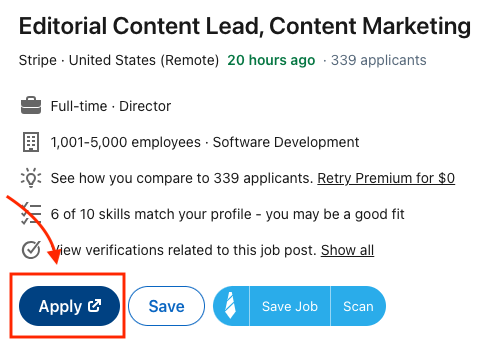
Since you must do the same manual steps for every job application, your progress towards landing a job offer will be painfully slow.
LinkedIn Easy Apply button
The LinkedIn Easy Apply button allows you to apply to the job without ever leaving LinkedIn.
You don’t need to create a new profile for every job application; you can easily pull up existing information stored on LinkedIn for the job you are applying for.
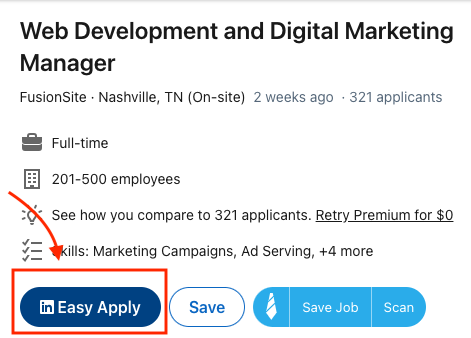
LinkedIn Easy Apply is all about speed and convenience. With this tool you can:
- Submit many job applications with minimal time and effort. 😊
- Eliminate time-consuming tasks like creating new accounts, filling out forms, and uploading documents. 📝
- Easily attach your LinkedIn resume to any job application. 💻
- Check who works at the company among your connections and school alumni. 🎓
- See the link to the company’s website and check the recruiter posting for the job. 🤝
Here are some things to keep in mind when you use Easy Apply:
- Since the application process is so easy, lots of people will apply. Therefore, it is difficult to stand out from the crowd.
- LinkedIn Easy Apply uses existing information in your profile. This means you cannot customize your LinkedIn profile for every job application.
- There is no opportunity to present referrals and references.
- There is no space to present your case as to why you are the strongest candidate for the job.
Applying through LinkedIn Easy Apply is simple and fast. Here’s how.
1. Search for the job you are interested in on LinkedIn’s jobs tab. Use LinkedIn’s filters to narrow your job search.

2. On the results tab, look for job postings that have the Easy Apply feature.
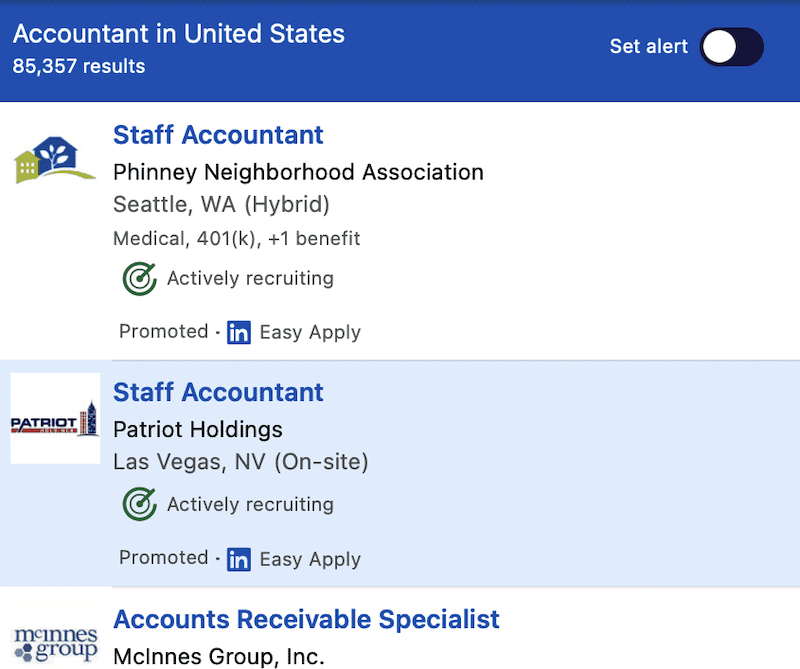
3. Select the job you want and click on the Easy Apply button.
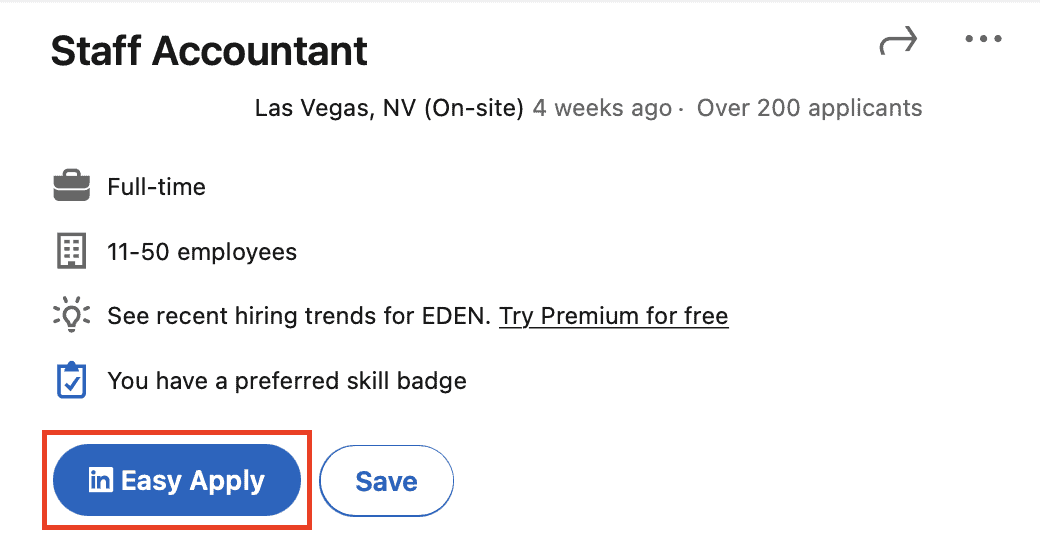
4. The application is straightforward. A popup box will appear; you just need to fill in the required fields and then click Next. To make this process faster, LinkedIn populates specific fields with pre-saved information in your LinkedIn profile.
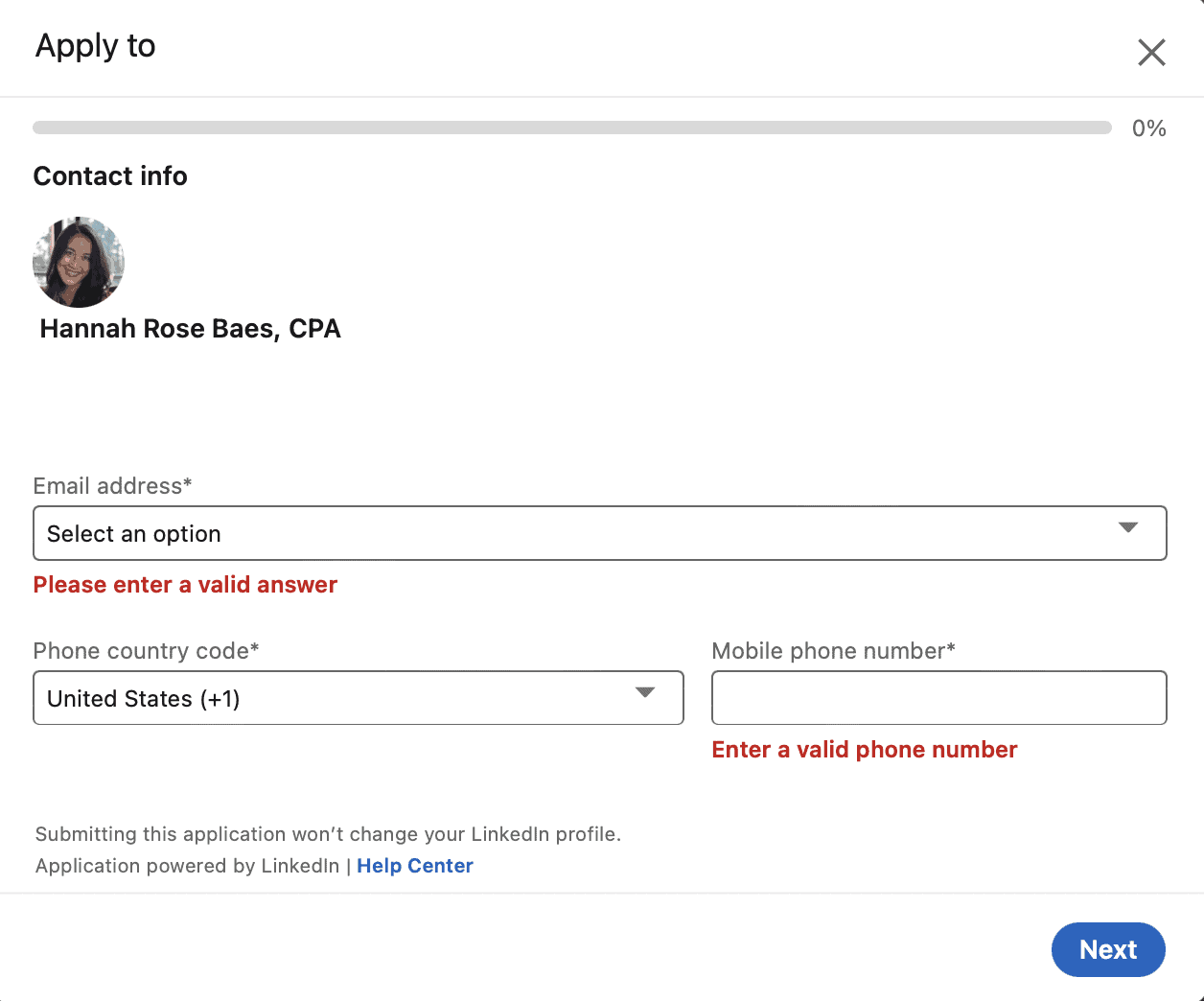
5. Upload your resume. You can either upload a resume from your computer or device or choose an existing LinkedIn resume .
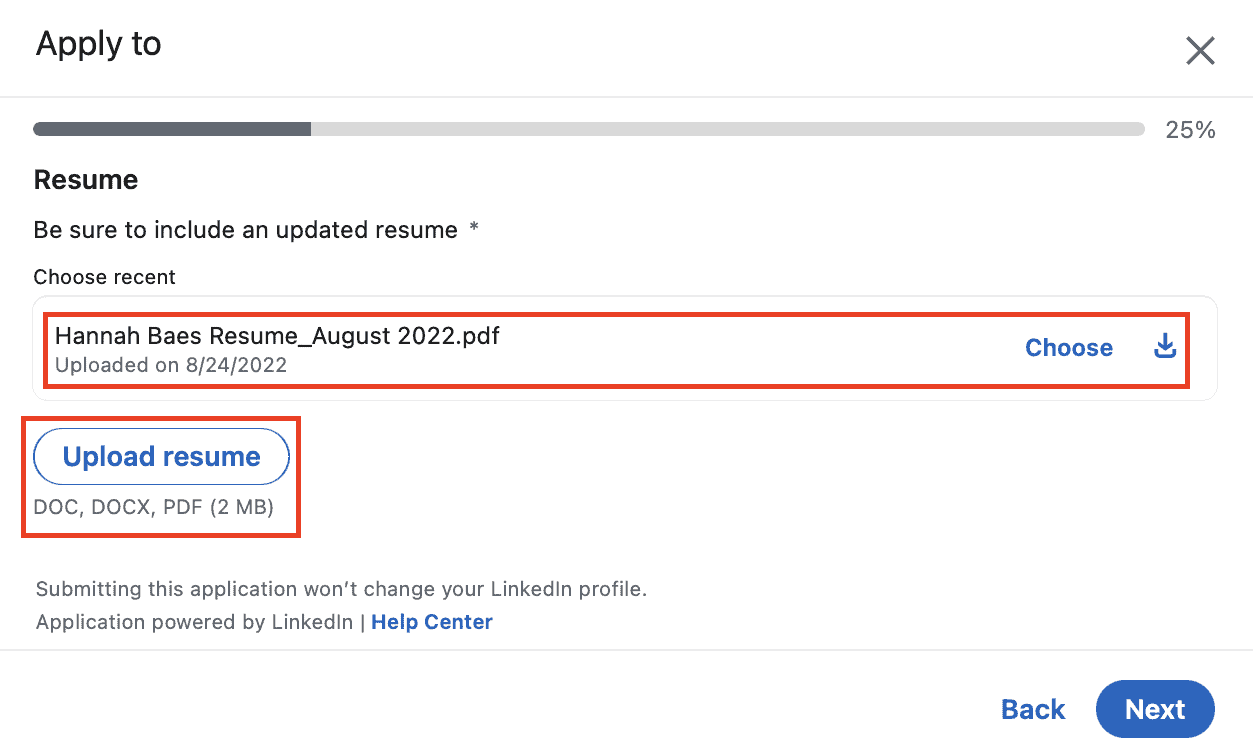
After uploading your resume, proceed with your application by clicking Next.
6. There will be a few more screening questions that you need to answer. These include things like years of experience, education, and your willingness to work onsite or relocate if you are from a different city or country.
Employers can customize these screening questions to help narrow their selection and streamline their hiring process.
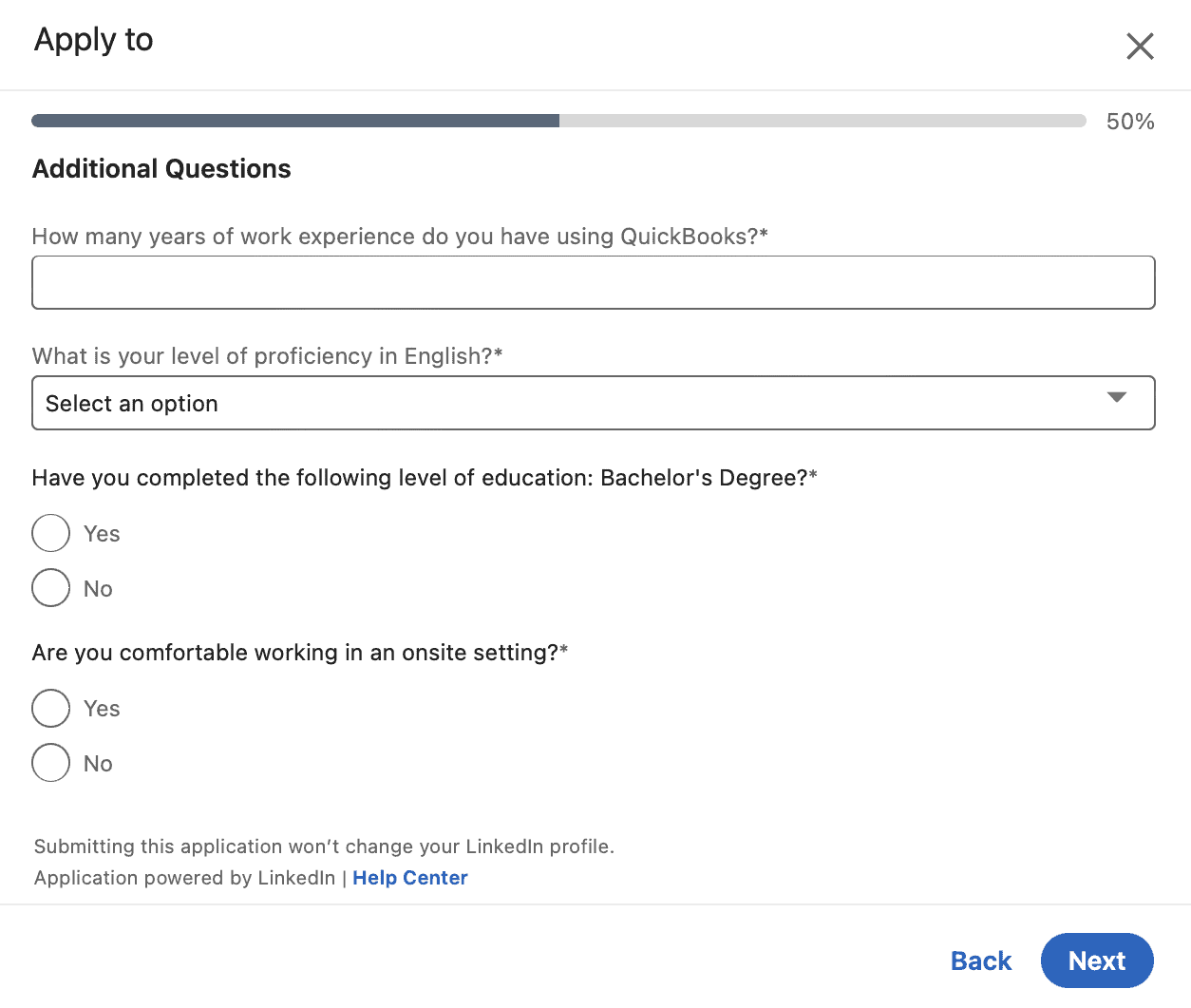
7. Once finished, you will see a summary of all your inputs. When everything is all set, click Submit.
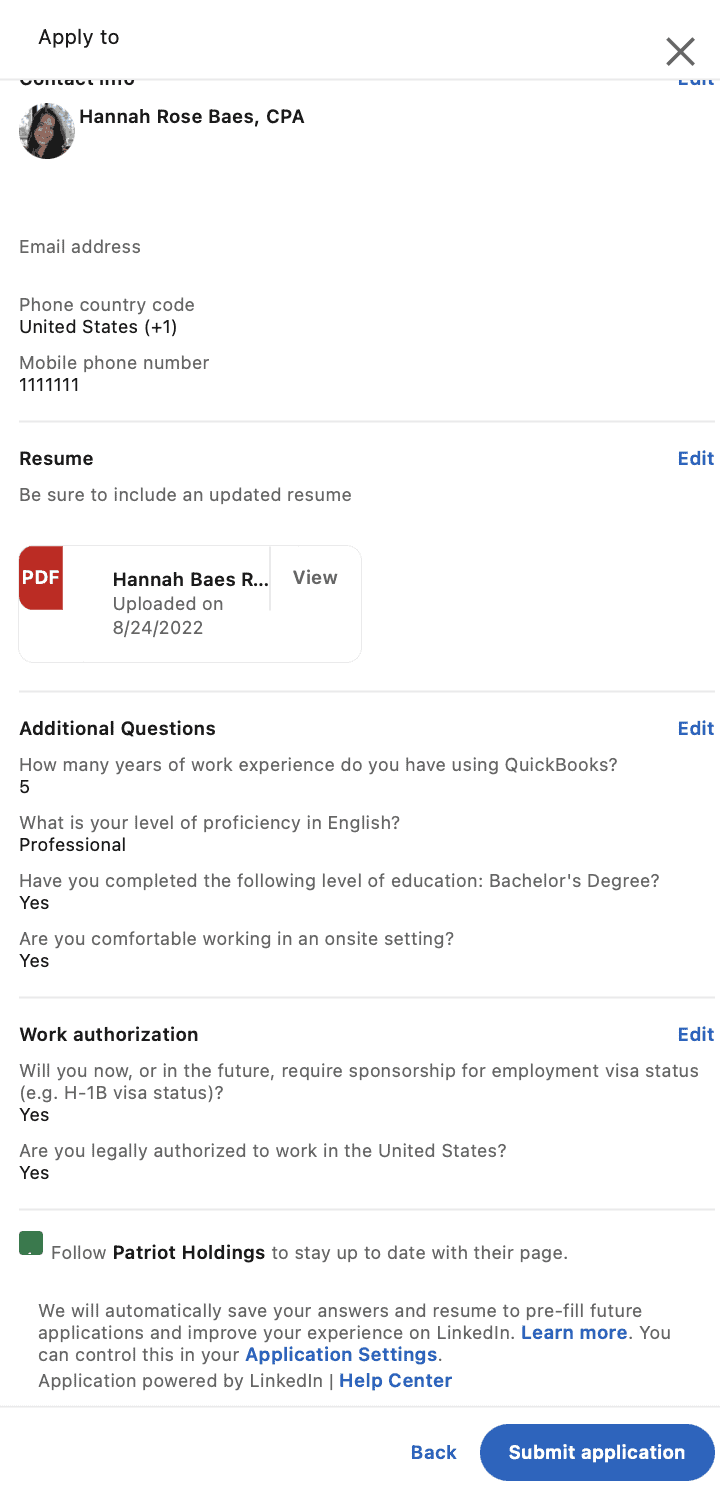
8. When you submit your application, LinkedIn notifies the hiring manager who posted the job. You will also receive application updates when the hiring manager views your application or downloads your attached resume.
After you submit your application, you might notice a message that says “your profile was shared with the job poster.”

Here is what these profiles look like from the recruiter’s side:
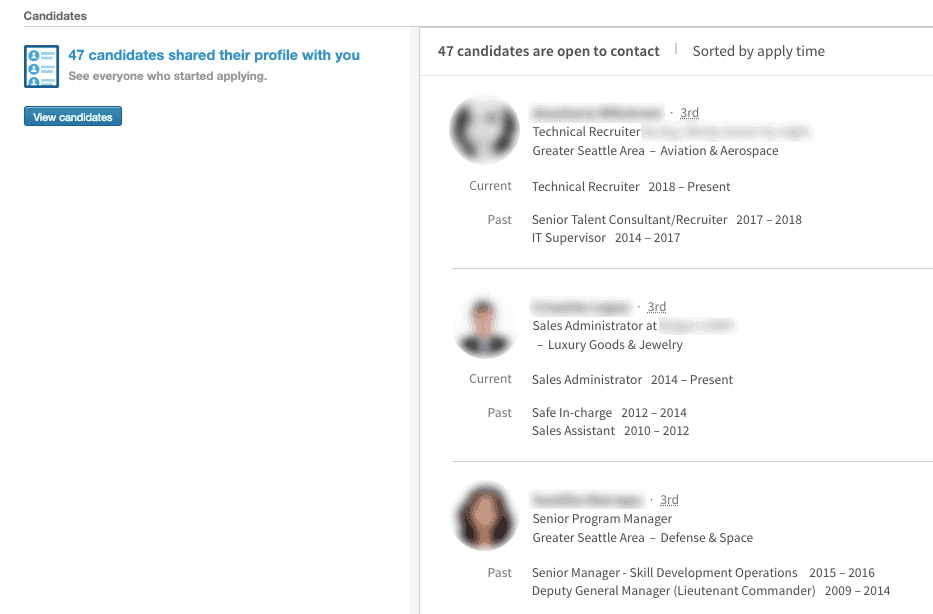
When recruiters view your application, they will see a quick summary of your LinkedIn information.
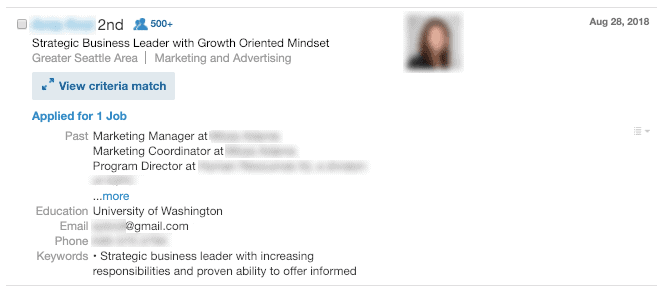
Here are the specific details recruiters will see:
- Your LinkedIn profile picture
- Your LinkedIn headline
- Number of jobs you applied for
- Your four most recent work experiences (job titles + company)
- Your education
- Skills you listed and relevant keywords
- Your contact information
For more information, see our Job Seeker’s Guide to LinkedIn Recruiter Search .
Since recruiters only spend an average of 7 seconds to scan your information and there are around 250 job applications for every job post, you need to quickly grab the recruiter’s attention and hold their interest.
Here are the best ways to do that:
1. Have a great LinkedIn photo
Not using a photo could get you passed over, so upload a photo and make it a good one. This means something professional, crisp, and well-lit.
Read the full guide: 5 Tips for Taking a Professional LinkedIn Profile Picture
2. Write a strong LinkedIn headline and summary
By default, LinkedIn creates your headline based on your current job title and company. For example: “Web Developer at Jobscan.”
But with 220 characters to work with, stopping there is a wasted opportunity. Add in other details that describe what you do for the company.
A LinkedIn summary is a brief, personal statement at the top of your profile that highlights your professional background, skills, and career goals. It’s important because it provides a snapshot of who you are, helping to attract recruiters and connections by making a strong first impression.
3. Align your location and industry
Ensure that your location aligns with where you’re looking for jobs, not necessarily where you currently live or work. Same thing for the industry. Think about where you’re trying to take your career rather than where it’s historically been.
4. Optimize your LinkedIn profile to match the job
One of the best ways to grab a recruiter’s attention is to optimize your profile so it matches the job you’re applying for.
This tailored approach helps you stand out in a competitive job market by showcasing your specific skills and experiences that resonate with the desired job’s needs.
Optimizing your LinkedIn profile involves several key steps:
- Analyze the job description – Carefully read the job description to identify key skills, qualifications, and responsibilities. Look for specific keywords and phrases that are emphasized.
- Update your headline and summary – Your LinkedIn headline should reflect your current role or the role you’re targeting. Your summary should provide a concise overview of your skills and experiences that align with the job requirements.
- Tailor your experience section – Highlight experiences and achievements that are most relevant to the job. Use the same keywords found in the job description to describe your responsibilities and accomplishments.
The easiest and most effective way to optimize your profile to match the job is to use Jobscan’s LinkedIn optimizer . This tool will help you craft a profile that exactly matches the jobs that you want to be selected for.
To use this tool, all you need to do is follow three simple steps:
- Step 1: Connect your LinkedIn profile to the LinkedIn optimizer tool.
- Step 2: Upload your LinkedIn profile as a PDF file to the tool.
- Step 3: Paste in at least three job descriptions into the tool for best results.
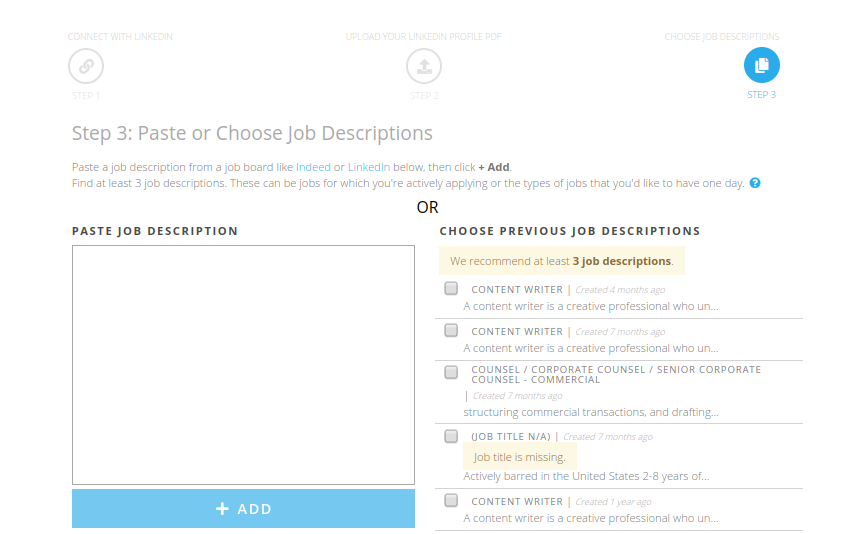
- Step 4: Once you click “Scan” a LinkedIn Report will be generated. It will show your match score, areas that need improvement, and how to fix them. Here’s a preview of one section of the report:
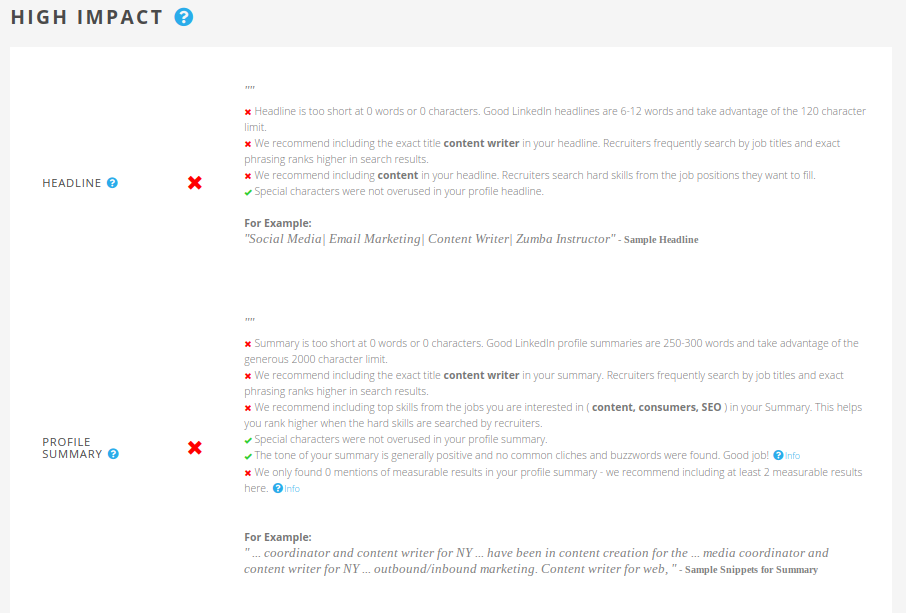
94% of recruiters use LinkedIn to vet job candidates. Optimize your LinkedIn profile and show that you’re a recruiter’s perfect candidate.
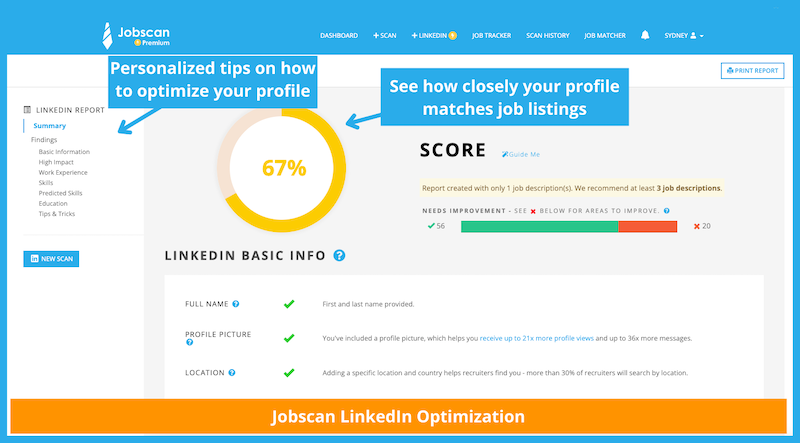
Click here to start optimizing your LinkedIn profile
While LinkedIn Easy Apply applications include a place to upload your resume, it’s often marked “optional” and is deemphasized within the recruiter’s dashboard.
LinkedIn sees itself as the evolution of resumes, so it’s not surprising that resumes are merely a supplemental part of many LinkedIn applications.
So, yes, upload your resume to LinkedIn and tailor it to the job. But don’t submit your LinkedIn application hoping your resume will do the heavy lifting.
Your candidacy will likely live and die with your LinkedIn profile so it needs to be in tip-top shape.
Here are some resources to guide you through building an optimized LinkedIn profile:
- LinkedIn Profile Writing Guide
- Quick Updates to Improve Your LinkedIn Profile
- Impactful LinkedIn Headline Examples from Real People
- LinkedIn Recommendations
- Taking a Professional LinkedIn Profile Picture (Without Paying for Headshots)
- LinkedIn Certifications
- LinkedIn Featured Section
Here are instances when it’s smart to apply for jobs on LinkedIn through its Easy Apply feature:
- You’re trying to cast a wider net in your job search and get your profile to as many recruiters as possible.
- You have a killer LinkedIn profile that’s updated and optimized for the jobs you are interested in.
- You have limited time and your job strategy is sending to as many job postings as quickly as possible.
- You’re applying for jobs that don’t require specialized skills.
- You don’t have time to do the traditional job application process. Applying through Easy Apply is better than nothing.
- You have a tailored resume for every job application.
- You can follow up with the job application instantly. This will signal to recruiters that you really want the job.
- The job post specifically instructs that you apply through Easy Apply on LinkedIn.
As with any other tool and strategy, there are times when it’s not right to use the Easy Apply option. For example:
- You’re applying for your dream job. Applying through the Easy Apply option is not the best platform to make you stand out. You need to carefully tailor your resume and cover letter (when needed) and optimize your LinkedIn profile to match what the recruiter wants.
- You want to showcase your unique skill sets and values.
- Your LinkedIn profile is bare bones, outdated, or simply generic.
- You’re looking for your first job. Recruiters will use filters and check on the critical match score to screen applicants. As a recent graduate, it will be hard for you to stand out.
- You are changing careers. The Easy Apply option doesn’t give enough platform where you can convince recruiters why you are the best for the job even when your past experiences aren’t related to the job.
- You have employment gaps. Easy Apply doesn’t allow you to explain your work history gaps and prove to recruiters that you are up to the job.
LinkedIn Easy Apply is a useful tool for job seekers. But relying on the application alone and leaving your LinkedIn profile as is will not land you that job offer.
Here are some things you can do to strengthen your application and get recruiters and hiring managers to notice you.
1. Optimize your LinkedIn profile to match the jobs that you are interested in
When applying for jobs on LinkedIn, recruiters and hiring managers use the platform as their ATS . So be sure to incorporate skills and relevant keywords found that recruiters might search for into your LinkedIn profile. These skills and keywords can be found in the job description.
Consider using a tool like Jobscan’s LinkedIn Opimization tool . It scores your LinkedIn profile based on keywords, completed fields, and optimized content in your headline, summary, and work experience.
An optimized profile that’s updated and professional is your ticket to grabbing the recruiter’s attention and landing a job interview.
2. Reach out to people who are currently in the job position you want
LinkedIn Easy Apply shows you the number of connections you have who work in the company you’re applying to. Reach out to these people and ask for referrals. You can even ask them for tips on your application.
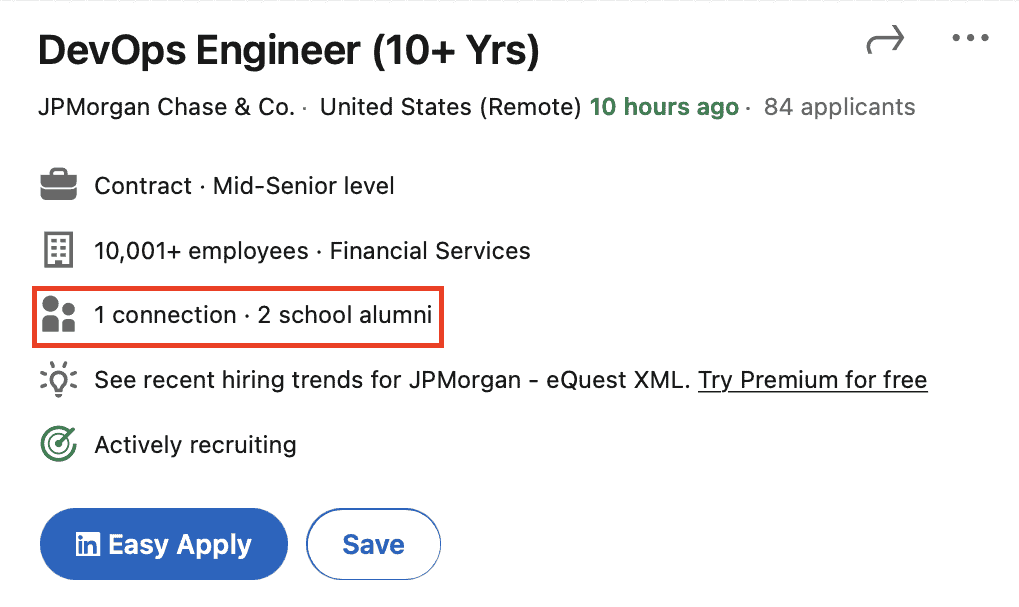
Search for the company you want to apply in, and look for people who are currently working there. Then connect with them and ask them for more information, tips, and even recommendations.
- Pro Tip: Did you know that 85% of jobs are filled through networking and connections? Use your network today and connect with people who can help you land your dream job!
3. Connect with the recruiter
Some job posts on LinkedIn disclose the name of the recruiter.
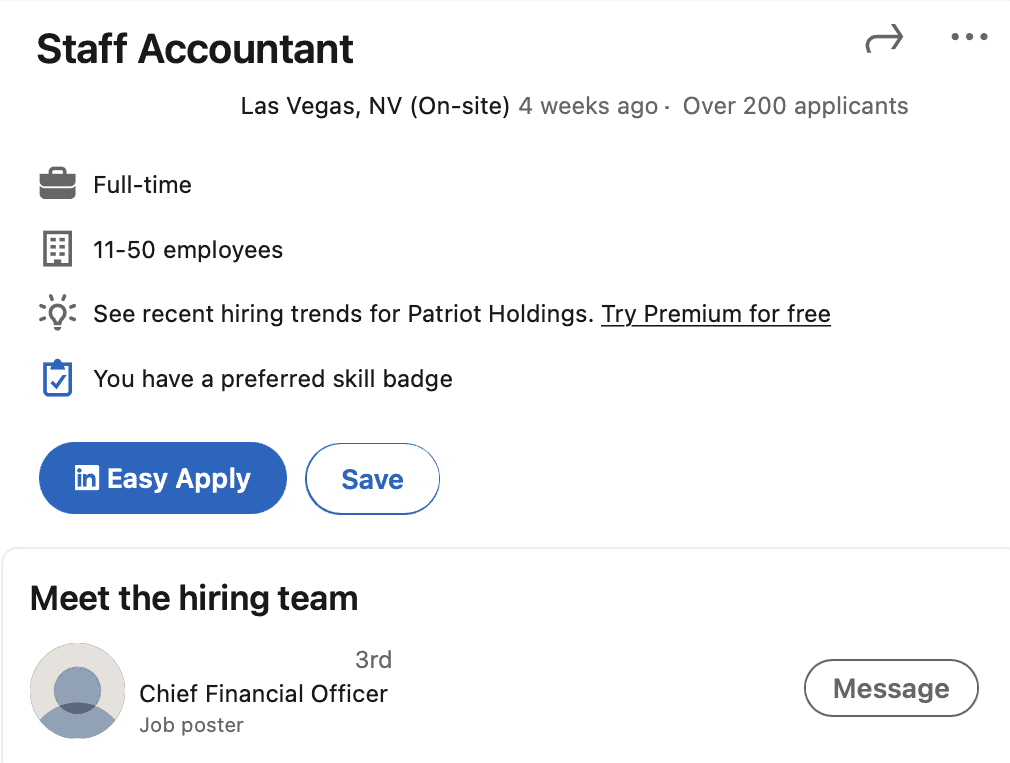
Click on the name and connect with the recruiter. Send the recruiter a message and share your interest in the job and why you are the best fit. This is a long shot but landing your dream job is worth it.
4. Tailor your resume to the job description
Since LinkedIn allows you to attach your resume, make sure that you upload a resume that’s optimized for the job you are applying for.
This way, when recruiters view your resume, they can clearly see the value that you bring and why you are the best job candidate for the position.
To fully optimize your resume so it’s perfectly tailored for each job you apply for, consider using an online tool like Jobscan’s resume scanner .
5. Follow instructions
Be sure to carefully read the instructions found on the job post carefully. Some recruiters like to use instructions to weed out applicants.
For instance, a recruiter might ask you to apply via Easy Apply and through the company website. Specific instructions like this show the recruiter who paid attention to the job ad and are really interested to get the offer.
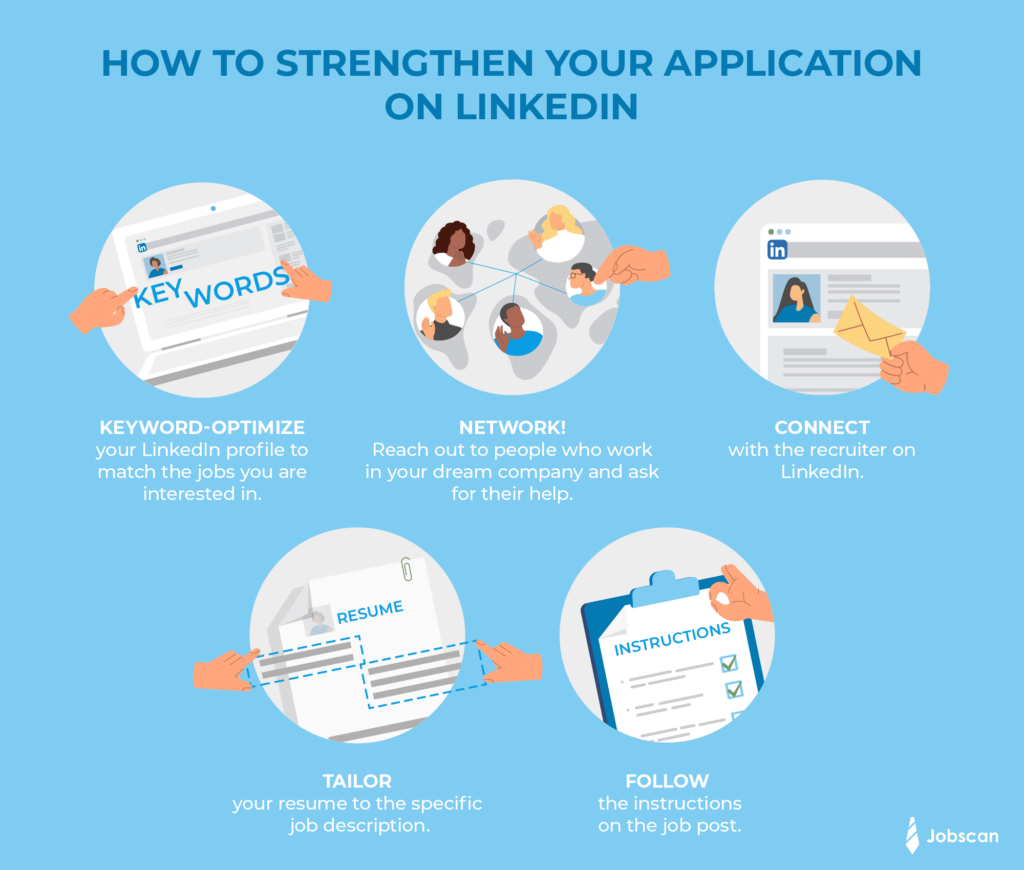
LinkedIn Easy Apply simplifies the job application process and allows job seekers to easily send out applications without having to leave LinkedIn. This feature saves you time and effort and allows you to cast a wider net in your job search.
Here’s our LinkedIn Easy Apply summary of key points:
- Although LinkedIn Easy Apply makes the application process more efficient, it also raises competition since the process is so easy.
- Although the resume is deemphasized when applying through Easy Apply, it is always a smart move to attach a resume that is tailored to the specific job description of the position you are applying for.
- To grab the recruiter’s attention, update your LinkedIn profile. Optimize your profile for the jobs you want and pepper it with keywords that recruiters are looking for.
- Networking is still the key! Reach out to LinkedIn members who work at the company you like and connect with them.
- Connect with the recruiter. Tell them about your interest in the job and show them why they need to take a chance on you.
- It is not the number of applications you send out that lands you the job. It is the quality of your application, the strength of your credentials and work experiences, and what you bring to the table that gets you the offer.
The best way to ensure that your profile matches jobs you’re interested in is by using Jobscan’s LinkedIn optimization tool . It analyzes your LinkedIn profile, checks whether it is optimized for the jobs you are interested in, and gives you an accurate Match Score.
What does Easy Apply on LinkedIn mean?
Easy Apply on LinkedIn is one of two options you have when applying for a job on LinkedIn. The Easy Apply feature allows you to submit your job application without leaving the platform. It also allows you to send many job applications to different companies with minimal effort.
Do employers look at LinkedIn Easy Apply?
Yes. Employers, recruiters, and hiring managers look at LinkedIn Easy Apply. In fact, 87 percent of recruiters use LinkedIn to look for new employees. The LinkedIn Easy Apply option makes it easy for them to look at applications and sift through the candidates.
Does LinkedIn Easy Apply work?
Yes. LinkedIn Easy Apply works. Most of the jobs posted on LinkedIn have this feature to make it easier for recruiters to get leads. In fact, eight people get hired on LinkedIn every minute.
Where is the Easy Apply button on LinkedIn?
The Easy Apply button is the blue button right below the basic company information on the job post.
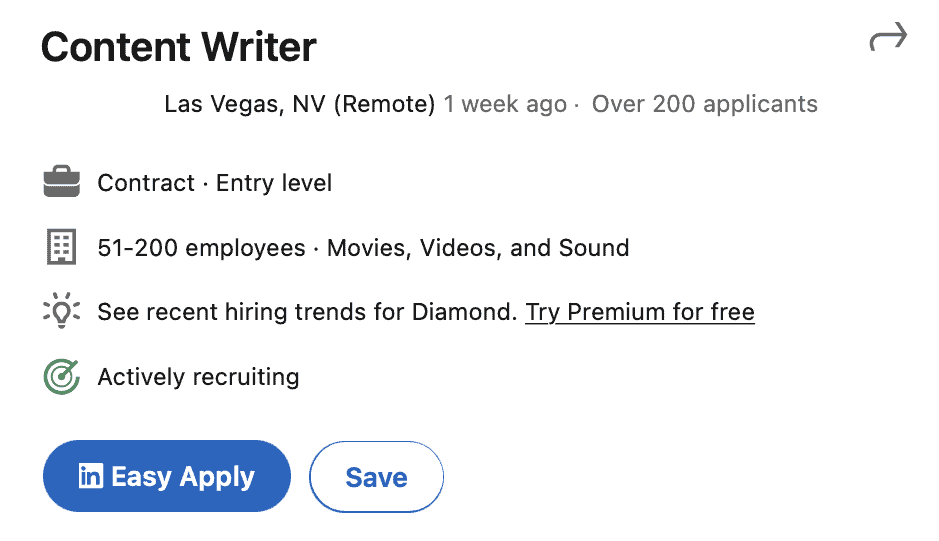
Do the recruiters get notified when you submit your application?
Yes. LinkedIn immediately notifies the job poster when you submit your application.
Does LinkedIn give updates about the status of your application?
LinkedIn sends you notifications when:
- The job poster opened your application, including your answers to their screening questions and introductions (if applicable.)
- The job poster downloaded your attached resume.
How does LinkedIn Easy Apply make your application more efficient?
Here’s how LinkedIn Easy Apply makes your life easier:
- It streamlines the application process and allows you to apply to multiple job posts without leaving LinkedIn.
- LinkedIn stores your saved answers from previous applications. This allows you to reuse your uploaded resume and some other information for your future applications. This saves you time and energy.
How many job applications should you send?
You should send at least two to three job applications every day. But keep in mind that it is not the quantity that gets you the job but the quality of your application and the skills and professional experiences that you have.
Read the full guide: How Many Jobs Should I Apply To?
How to apply for jobs on LinkedIn?
There are two ways to apply for a job on LinkedIn:
- LinkedIn Apply
- LinkedIn Easy Apply
The first option is where you will be redirected to a page outside of LinkedIn where you may proceed with the application process.
LinkedIn Easy Apply allows you to apply for a job without leaving LinkedIn at all. You may only use this feature on jobs that have it activated.
Is LinkedIn Easy Apply confidential?
Any job application on LinkedIn, including those done via LinkedIn Easy Apply, is completely confidential. This means only recruiters that posted the jobs you applied for will be able to view your application.
Moreover, your job applications won’t be reflected on your LinkedIn profile, and your connections won’t be able to see whether you’ve applied to any jobs.
Your resume will also not be visible on your profile unless you share it via a public post or highlight it on your profile’s Featured section.
Is LinkedIn a good way to apply for a job?
LinkedIn is the best job search platform, with eight people getting hired every minute!
Also, 94 percent of recruiters use LinkedIn to vet candidates, which means that having an optimized LinkedIn profile has never been more important.
To make sure your profile is fully optimized, use Jobscan’s LinkedIn optimizer .
This tool will analyze your profile to determine how well you match your preferred jobs. It will also show you the exact information that each profile section needs to make you the perfect fit.
How to add a cover letter to LinkedIn Easy Apply
When applying via LinkedIn Easy Apply, you won’t be able to add a cover letter unless recruiters specifically ask for it in any of the screening questions.
But there is a way to go around this. You can put your cover letter in the same PDF file as your resume. This way, you can upload a new and customized resume when submitting an application, which will automatically include your cover letter as well.
You can also send your cover letter via LinkedIn InMail message. However, this feature is only possible if you have a premium account.
Check your cover letter to see if it’s fully optimized with Jobscan’s cover letter checker . And if you don’t have a cover letter already written, you can generate one with just one click with Jobscan’s cover letter generator .
What happens after you apply on LinkedIn Easy Apply?
Once you’ve applied for a job via LinkedIn Easy Apply, recruiters will be notified that you submitted an application. When you check the job ad, you will also notice a message that says, “Your profile was shared with the job poster.” This means that recruiters can now view your LinkedIn profile, resume, and answers to any screening questions.
How to turn off Easy Apply on LinkedIn?
Only recruiters or job posters are able to turn LinkedIn Easy Apply on or off. If you are a job seeker, you won’t have any control over which jobs you will be able to apply for via the Easy Apply feature.
How to change your resume on LinkedIn Easy Apply?
Once you’ve submitted your application via LinkedIn Easy Apply, you won’t be able to withdraw or modify your application. You also won’t be able to update your resume.
Because of this, make sure to check your application details, resume, and screening answers using the application preview before submitting. During the preview stage, you will be able to edit information and change your resume.
How to enable Easy Apply on LinkedIn?
If you’re a job seeker, you won’t be able to enable or disable LinkedIn Easy Apply on jobs. Only those that have this plugin enabled by the recruiters or job posters themselves will be able to accommodate applications via LinkedIn Easy Apply.

Related articles…
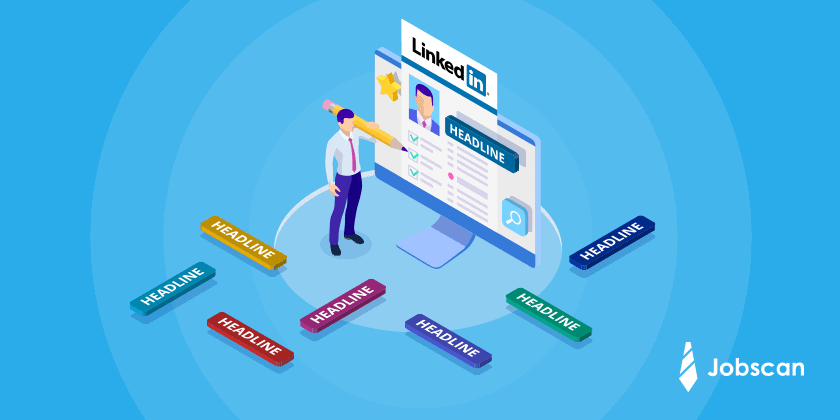
How to Write a LinkedIn Headline (with 20+ Examples)
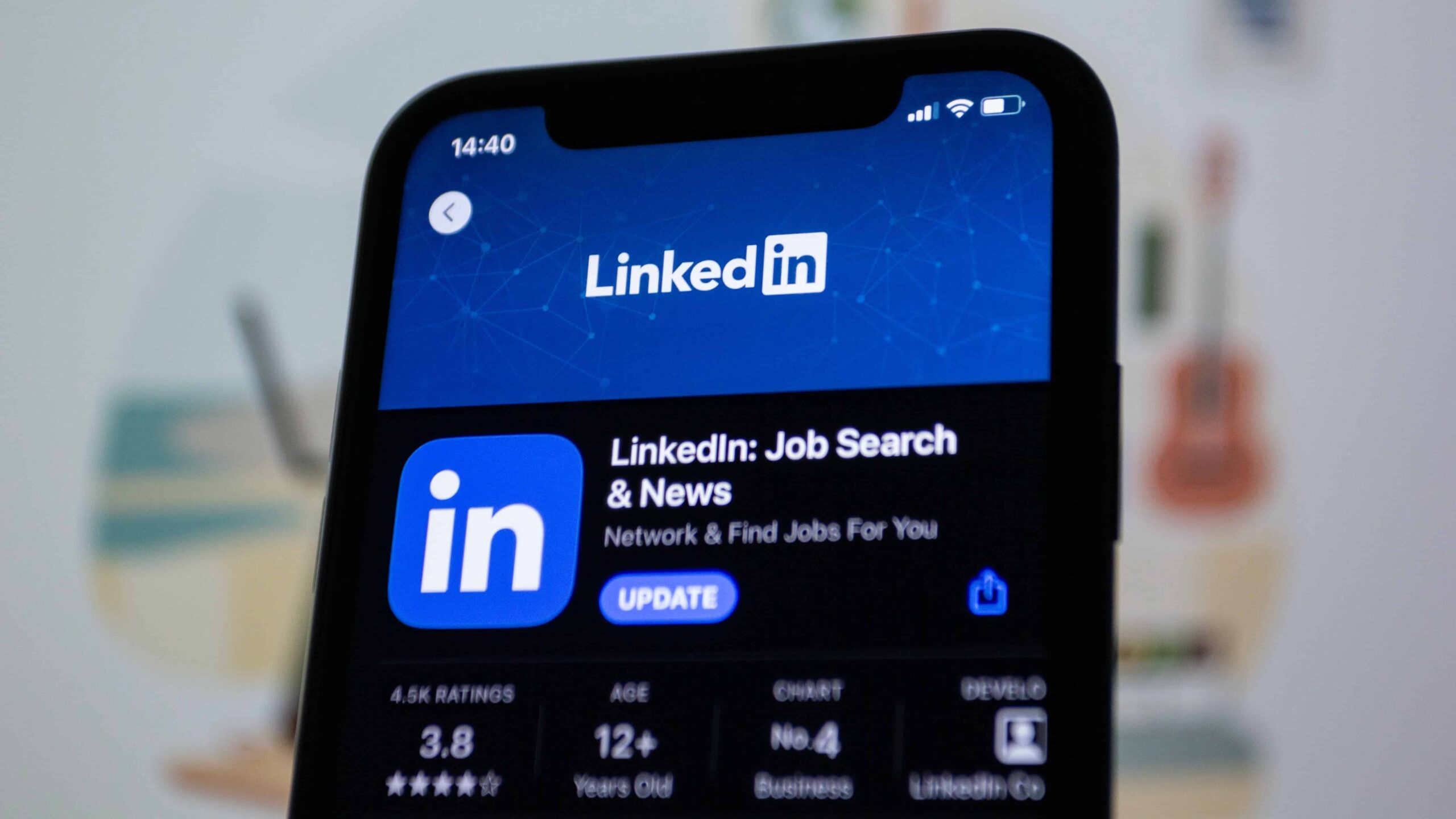
28 LinkedIn Profile Tips to Supercharge Your Job Opportunities

75+ Free Certifications to Help You Land Your Dream Job

Related Articles

July 17, 2024
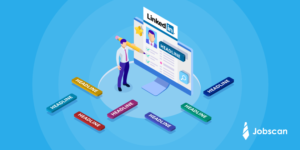
June 27, 2024
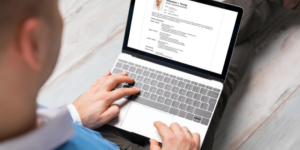
January 3, 2024
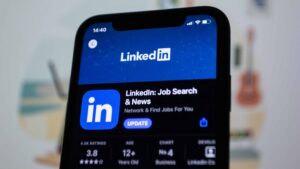
November 8, 2023

September 22, 2023
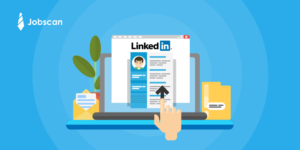
July 20, 2023

July 18, 2023
July 12, 2023
Join 2 million job seekers who get bi-weekly job search tips
Get insider knowledge and ready-to-use job-seeking tips and hacks delivered to your inbox.

How it works
Transform your enterprise with the scalable mindsets, skills, & behavior change that drive performance.
Explore how BetterUp connects to your core business systems.
We pair AI with the latest in human-centered coaching to drive powerful, lasting learning and behavior change.
Build leaders that accelerate team performance and engagement.
Unlock performance potential at scale with AI-powered curated growth journeys.
Build resilience, well-being and agility to drive performance across your entire enterprise.
Transform your business, starting with your sales leaders.
Unlock business impact from the top with executive coaching.
Foster a culture of inclusion and belonging.
Accelerate the performance and potential of your agencies and employees.
See how innovative organizations use BetterUp to build a thriving workforce.
Discover how BetterUp measurably impacts key business outcomes for organizations like yours.
A demo is the first step to transforming your business. Meet with us to develop a plan for attaining your goals.

- What is coaching?
Learn how 1:1 coaching works, who its for, and if it's right for you.
Accelerate your personal and professional growth with the expert guidance of a BetterUp Coach.
Types of Coaching
Navigate career transitions, accelerate your professional growth, and achieve your career goals with expert coaching.
Enhance your communication skills for better personal and professional relationships, with tailored coaching that focuses on your needs.
Find balance, resilience, and well-being in all areas of your life with holistic coaching designed to empower you.
Discover your perfect match : Take our 5-minute assessment and let us pair you with one of our top Coaches tailored just for you.

Research, expert insights, and resources to develop courageous leaders within your organization.
Best practices, research, and tools to fuel individual and business growth.
View on-demand BetterUp events and learn about upcoming live discussions.
The latest insights and ideas for building a high-performing workplace.
- BetterUp Briefing
The online magazine that helps you understand tomorrow's workforce trends, today.
Innovative research featured in peer-reviewed journals, press, and more.
Founded in 2022 to deepen the understanding of the intersection of well-being, purpose, and performance
We're on a mission to help everyone live with clarity, purpose, and passion.
Join us and create impactful change.
Read the buzz about BetterUp.
Meet the leadership that's passionate about empowering your workforce.
For Business
For Individuals
How to write a great cover letter in 2024: tips and structure

A cover letter is a personalized letter that introduces you to a potential employer, highlights your qualifications, and explains why you're a strong fit for a specific job.
Hate or love them, these brief documents allow job seekers to make an impression and stand out from the pile of other applications. Penning a thoughtful cover letter shows the hiring team you care about earning the position.
Here’s everything you need to know about how to write a cover letter — and a great one, at that.
What is a cover letter and why does it matter?
A professional cover letter is a one-page document you submit alongside your CV or resume as part of a job application. Typically, they’re about half a page or around 150–300 words.
An effective cover letter doesn’t just rehash your CV; it’s your chance to highlight your proudest moments, explain why you want the job, and state plainly what you bring to the table.
Show the reviewer you’re likable, talented, and will add to the company’s culture . You can refer to previous jobs and other information from your CV, but only if it helps tell a story about you and your career choices .
What 3 things should you include in a cover letter?
A well-crafted cover letter can help you stand out to potential employers. To make your cover letter shine, here are three key elements to include:
1. Personalization
Address the hiring manager or recruiter by name whenever possible. If the job posting doesn't include a name, research to find out who will be reviewing applications. Personalizing your cover letter shows that you've taken the time to tailor your application to the specific company and role.
2. Highlight relevant achievements and skills
Emphasize your most relevant skills , experiences, and accomplishments that directly relate to the job you're applying for. Provide specific examples of how your skills have benefited previous employers and how they can contribute to the prospective employer's success. Use quantifiable achievements , such as improved efficiency, cost savings, or project success, to demonstrate your impact.
3. Show enthusiasm and fit
Express your enthusiasm for the company and the position you're applying for. Explain why you are interested in this role and believe you are a good fit for the organization. Mention how your values, goals, and skills align with the company's mission and culture. Demonstrating that you've done your research can make a significant impression.
What do hiring managers look for in a cover letter?
Employers look for several key elements in a cover letter. These include:
Employers want to see that your cover letter is specifically tailored to the position you are applying for. It should demonstrate how your skills, experiences, and qualifications align with the job requirements.
Clear and concise writing
A well-written cover letter is concise, easy to read, and error-free. Employers appreciate clear and effective communication skills , so make sure your cover letter showcases your ability to express yourself effectively.
Demonstrated knowledge of the company
Employers want to see that you are genuinely interested in their organization. Mention specific details about the company, such as recent achievements or projects, to show that you are enthusiastic about joining their team.
Achievements and accomplishments
Highlight your relevant achievements and accomplishments that demonstrate your qualifications for the position. Use specific examples to showcase your skills and show how they can benefit the employer.
Enthusiasm and motivation
Employers want to hire candidates who are excited about the opportunity and motivated to contribute to the company's success. Express your enthusiasm and passion for the role and explain why you are interested in working for the company.
Professionalism
A cover letter should be professional in tone and presentation. Use formal language, address the hiring manager appropriately, and follow standard business letter formatting.

How do you structure a cover letter?
A well-structured cover letter follows a specific format that makes it easy for the reader to understand your qualifications and enthusiasm for the position. Here's a typical structure for a cover letter:
Contact information
Include your name, address, phone number, and email address at the top of the letter. Place your contact information at the beginning so that it's easy for the employer to reach you.
Employer's contact information
Opening paragraph, middle paragraph(s), closing paragraph, complimentary close, additional contact information.
Repeat your contact information (name, phone number, and email) at the end of the letter, just in case the employer needs it for quick reference.
Remember to keep your cover letter concise and focused. It should typically be no more than one page in length. Proofread your letter carefully to ensure it is free from spelling and grammatical errors. Tailor each cover letter to the specific job application to make it as relevant and impactful as possible.
How to write a good cover letter (with examples)
The best letters are unique, tailored to the job description, and written in your voice — but that doesn’t mean you can’t use a job cover letter template.
Great cover letters contain the same basic elements and flow a certain way. Take a look at this cover letter structure for ref erence while you construct your own.
1. Add a header and contact information
While reading your cover letter, the recruiter shouldn’t have to look far to find who wrote it. Your document should include a basic heading with the following information:
- Pronouns (optional)
- Location (optional)
- Email address
- Phone number (optional)
- Relevant links, such as your LinkedIn profile , portfolio, or personal website (optional)
You can pull this information directly from your CV. Put it together, and it will look something like this:
Christopher Pike
San Francisco, California
Alternatively, if the posting asks you to submit your cover letter in the body of an email, you can include this information in your signature. For example:
Warm regards,
Catherine Janeway
Bloomington, Indiana
(555) 999 - 2222

2. Include a personal greeting
Always begin your cover letter by addressing the hiring manager — preferably by name. You can use the person’s first and last name. Make sure to include a relevant title, like Dr., Mr., or Ms. For example, “Dear Mr. John Doe.”
Avoid generic openings like “To whom it may concern,” “Dear sir or madam,” or “Dear hiring manager.” These introductions sound impersonal — like you’re copy-pasting cover letters — and can work against you in the hiring process.
Be careful, though. When using someone’s name, you don’t want to use the wrong title or accidentally misgender someone. If in doubt, using only their name is enough. You could also opt for a gender-neutral title, like Mx.
Make sure you’re addressing the right person in your letter — ideally, the person who’s making the final hiring decision. This isn’t always specified in the job posting, so you may have to do some research to learn the name of the hiring manager.
3. Draw them in with an opening story
The opening paragraph of your cover letter should hook the reader. You want it to be memorable, conversational, and extremely relevant to the job you’re pursuing.
There’s no need for a personal introduction — you’ve already included your name in the heading. But you should make reference to the job you’re applying for. A simple “Thank you for considering my application for the role of [job title] at [company],” will suffice.
Then you can get into the “Why” of your job application. Drive home what makes this specific job and this company so appealing to you. Perhaps you’re a fan of their products, you’re passionate about their mission, or you love their brand voice. Whatever the case, this section is where you share your enthusiasm for the role.
Here’s an example opening paragraph. In this scenario, you’re applying for a digital marketing role at a bicycle company:
“Dear Mr. John Doe,
Thank you for considering my application for the role of Marketing Coordinator at Bits n’ Bikes.
My parents bought my first bike at one of your stores. I’ll never forget the freedom I felt when I learned to ride it. My father removed my training wheels, and my mom sent me barrelling down the street. You provide joy to families across the country — and I want to be part of that.”
4. Emphasize why you’re best for the job
Your next paragraphs should be focused on the role you’re applying to. Highlight your skill set and why you’re a good fit for the needs and expectations associated with the position. Hiring managers want to know what you’ll bring to the job, not just any role.
Start by studying the job description for hints. What problem are they trying to solve with this hire? What skills and qualifications do they mention first or more than once? These are indicators of what’s important to the hiring manager.
Search for details that match your experience and interests. For example, if you’re excited about a fast-paced job in public relations, you might look for these elements in a posting:
- They want someone who can write social media posts and blog content on tight deadlines
- They value collaboration and input from every team member
- They need a planner who can come up with strong PR strategies
Highlight how you fulfill these requirements:
“I’ve always been a strong writer. From blog posts to social media, my content pulls in readers and drives traffic to product pages. For example, when I worked at Bits n’ Bikes, I developed a strategic blog series about bike maintenance that increased our sales of spare parts and tools by 50% — we could see it in our web metrics.
Thanks to the input of all of our team members, including our bike mechanics, my content delivered results.”
5. End with a strong closing paragraph and sign off gracefully
Your closing paragraph is your final chance to hammer home your enthusiasm about the role and your unique ability to fill it. Reiterate the main points you explained in the body paragraphs and remind the reader of what you bring to the table.
You can also use the end of your letter to relay other important details, like whether you’re willing to relocate for the job.
When choosing a sign-off, opt for a phrase that sounds professional and genuine. Reliable options include “Sincerely” and “Kind regards.”
Here’s a strong closing statement for you to consider:
“I believe my enthusiasm, skills, and work experience as a PR professional will serve Bits n’ Bikes very well. I would love to meet to further discuss my value-add as your next Director of Public Relations. Thank you for your consideration. I hope we speak soon.

Tips to write a great cover letter that compliments your resume
When writing your own letter, try not to copy the example excerpts word-for-word. Instead, use this cover letter structure as a baseline to organize your ideas. Then, as you’re writing, use these extra cover letter tips to add your personal touch:
- Keep your cover letter different from your resume : Your cover letter should not duplicate the information on your resume. Instead, it should provide context and explanations for key points in your resume, emphasizing how your qualifications match the specific job you're applying for.
- Customize your cover letter . Tailor your cover letter for each job application. Address the specific needs of the company and the job posting, demonstrating that you've done your homework and understand their requirements.
- Show enthusiasm and fit . Express your enthusiasm for the company and position in the cover letter. Explain why you are interested in working for this company and how your values, goals, and skills align with their mission and culture.
- Use keywords . Incorporate keywords from the job description and industry terms in your cover letter. This can help your application pass through applicant tracking systems (ATS) and demonstrate that you're well-versed in the field.
- Keep it concise . Your cover letter should be succinct and to the point, typically no more than one page. Focus on the most compelling qualifications and experiences that directly support your application.
- Be professional . Maintain a professional tone and structure in your cover letter. Proofread it carefully to ensure there are no errors.
- Address any gaps or concerns . If there are gaps or concerns in your resume, such as employment gaps or a change in career direction, briefly address them in your cover letter. Explain any relevant circumstances and how they have shaped your qualifications and determination.
- Provide a call to action . Conclude your cover letter with a call to action, inviting the employer to contact you for further discussion. Mention that you've attached your resume for their reference.
- Follow the correct format . Use a standard cover letter format like the one above, including your contact information, a formal salutation, introductory and closing paragraphs, and your signature. Ensure that it complements your resume without redundancy.
- Pick the right voice and tone . Try to write like yourself, but adapt to the tone and voice of the company. Look at the job listing, company website, and social media posts. Do they sound fun and quirky, stoic and professional, or somewhere in-between? This guides your writing style.
- Tell your story . You’re an individual with unique expertise, motivators, and years of experience. Tie the pieces together with a great story. Introduce how you arrived at this point in your career, where you hope to go , and how this prospective company fits in your journey. You can also explain any career changes in your resume.
- Show, don’t tell . Anyone can say they’re a problem solver. Why should a recruiter take their word for it if they don’t back it up with examples? Instead of naming your skills, show them in action. Describe situations where you rose to the task, and quantify your success when you can.
- Be honest . Avoid highlighting skills you don’t have. This will backfire if they ask you about them in an interview. Instead, shift focus to the ways in which you stand out.
- Avoid clichés and bullet points . These are signs of lazy writing. Do your best to be original from the first paragraph to the final one. This highlights your individuality and demonstrates the care you put into the letter.
- Proofread . Always spellcheck your cover letter. Look for typos, grammatical errors, and proper flow. We suggest reading it out loud. If it sounds natural rolling off the tongue, it will read naturally as well.

Common cover letter writing FAQs
How long should a cover letter be.
A cover letter should generally be concise and to the point. It is recommended to keep it to one page or less, focusing on the most relevant information that highlights your qualifications and fits the job requirements.

Should I include personal information in a cover letter?
While it's important to introduce yourself and provide your contact information, avoid including personal details such as your age, marital status, or unrelated hobbies. Instead, focus on presenting your professional qualifications and aligning them with the job requirements.
Can I use the same cover letter for multiple job applications?
While it may be tempting to reuse a cover letter, it is best to tailor each cover letter to the specific job you are applying for. This allows you to highlight why you are a good fit for that particular role and show genuine interest in the company.
Do I need to address my cover letter to a specific person?
Whenever possible, it is advisable to address your cover letter to a specific person, such as the hiring manager or recruiter. If the job posting does not provide this information, try to research and find the appropriate contact. If all else fails, you can use a generic salutation such as "Dear Hiring Manager."
Should I include references in my cover letter?
It is generally not necessary to include references in your cover letter. Save this information for when the employer explicitly requests it. Instead, focus on showcasing your qualifications and achievements that make you a strong candidate for the position.
It’s time to start writing your stand-out cover letter
The hardest part of writing is getting started.
Hopefully, our tips gave you some jumping-off points and confidence . But if you’re really stuck, looking at cover letter examples and resume templates will help you decide where to get started.
There are numerous sample cover letters available online. Just remember that you’re a unique, well-rounded person, and your cover letter should reflect that. Using our structure, you can tell your story while highlighting your passion for the role.
Doing your research, including strong examples of your skills, and being courteous is how to write a strong cover letter. Take a breath , flex your fingers, and get typing. Before you know it, your job search will lead to a job interview.
If you want more personalized guidance, a specialized career coach can help review, edit, and guide you through creating a great cover letter that sticks.
Ace your job search
Explore effective job search techniques, interview strategies, and ways to overcome job-related challenges. Our coaches specialize in helping you land your dream job.
Elizabeth Perry, ACC
Elizabeth Perry is a Coach Community Manager at BetterUp. She uses strategic engagement strategies to cultivate a learning community across a global network of Coaches through in-person and virtual experiences, technology-enabled platforms, and strategic coaching industry partnerships. With over 3 years of coaching experience and a certification in transformative leadership and life coaching from Sofia University, Elizabeth leverages transpersonal psychology expertise to help coaches and clients gain awareness of their behavioral and thought patterns, discover their purpose and passions, and elevate their potential. She is a lifelong student of psychology, personal growth, and human potential as well as an ICF-certified ACC transpersonal life and leadership Coach.
3 cover letter examples to help you catch a hiring manager’s attention
Chatgpt cover letters: how to use this tool the right way, how to write an impactful cover letter for a career change, write thank you letters after interviews to stand out as job applicant, send a thank you email after an internship to boost your career, use professional reference templates to make hiring smoother, character references: 4 tips for a successful recommendation letter, what is a letter of intent examples on how to write one, tips and tricks for writing a letter of interest (with examples), how to ask for a letter of recommendation (with examples), how to quit a part-time job: 5 tips to leave on good terms, how to write a resume summary that works + examples, how to create a resume with chatgpt, cv versus resume demystify the differences once and for all, how to write a follow-up email 2 weeks after an interview, how and when to write a functional resume (with examples), how to give two weeks’ notice without burning bridges, how to cancel an interview but keep your job outlook bright, stay connected with betterup, get our newsletter, event invites, plus product insights and research..
3100 E 5th Street, Suite 350 Austin, TX 78702
- Platform Overview
- Integrations
- Powered by AI
- BetterUp Lead™
- BetterUp Manage™
- BetterUp Care®
- Sales Performance
- Diversity & Inclusion
- Case Studies
- Why BetterUp?
- About Coaching
- Find your Coach
- Career Coaching
- Communication Coaching
- Personal Coaching
- News and Press
- Leadership Team
- Become a BetterUp Coach
- BetterUp Labs
- Center for Purpose & Performance
- Leadership Training
- Business Coaching
- Contact Support
- Contact Sales
- Privacy Policy
- Acceptable Use Policy
- Trust & Security
- Cookie Preferences
How To Write a Cover Letter: The Ultimate Guide
You have crafted a compelling resume, updated your LinkedIn profile, and even short-listed promising open positions. The only thing left to do is write your cover letters. And for many people, this task proves to be unexpectedly challenging. A lot of questions arise. How do I address these letters? How long should they be? What should I write? And do I still need cover letters in 2022?
We have created this ultimate guide to answer all your questions and give step-by-step instructions on writing a good cover letter. This guide will teach you:
- How to format your cover letter
- What types of cover letters exist
- When do you need a cover letter even if an employer does not explicitly ask for one
- How to address and end a cover letter
- Common mistakes to avoid
We have also added cover letter examples and tips for making your documents even better.
Let’s get started!
What Is a Cover Letter?
A cover letter is a document you send with your resume. In this letter, you express your interest in a job opening, provide some context for your skills and experiences, and explain any parts of your resume that may be confusing or concerning for a potential employer.
Some people believe writing cover letters is a waste of time and that recruiters rarely read them. Others argue that employers still value these documents for insight into a candidate’s personality and motivations. And although there is some truth to the first point, studies show that cover letters are still well worth writing.
For example, ResumeGo surveyed 236 hiring professionals to determine if cover letters impact their decision-making process. Here are some results:
- 87% of recruiters said that they do indeed read cover letters
- 81% answered that they value letters written for a particular company and position more than generic ones
- 65% stated that cover letters significantly influence their hiring decisions
So, yes, your cover letter probably will be read. And yes, it better be good because it can be the reason you get an interview!
There are only two situations where you can skip cover letter writing. The first is if an employer explicitly states in their job ad that you should not include a cover letter. The second is if you are applying through an online form and there is no option to submit a cover letter. Otherwise, invest some time introducing yourself to a potential employer and showcasing why you will be a valuable asset to their company.
And again, your cover letter is the best place to add important information that does not belong on your resume. You can use a cover letter to explain employment gaps, mention that you are willing to relocate, describe why you are changing careers, or address any other concerns a hiring manager might have. You can also use a cover letter to ask a company if there is an open position that suits your qualifications, request help in the job search process from people in your network, or mention a person who referred you for a job.
Now, let’s take a closer look at different types of cover letters.
Types of Cover Letters
There are three main types of cover letters:
- Application cover letters are the most common type. These are sent together with resumes to apply for a particular job opening.
- Referral cover letters indicate a mutual contact you share with a recruiter. It might be an industry expert or an employee at the company where you are applying. Such letters are a powerful tool as hiring managers are likely to look closely at referred candidates.
- Prospecting cover letters or letters of interest, on the other hand, are not written for a specific position. People send these letters to companies where they would like to work. Prospecting cover letters ask if there are any unpublished openings where your qualifications and skills would be helpful.
- Networking cover letters are not sent to companies but instead to people in your network. These letters inform your former colleagues, alumni, or friends that you are looking for a new job and ask them if they know of any suitable opportunities.
In this guide, we will be focusing on application cover letters . However, you can also apply most of our recommendations to other types of cover letters.
Before we dive deeper into what you should include in your cover letters, let’s take a moment to discuss how your letters should look.
Cover Letter Format
The right format and proper structure are as important for your cover letter as its content. You need to make sure that your document is concise, clear, and easy to read. Luckily, this goal is not too difficult to achieve. Just follow these simple tips:
- Font: Use a standard font size (11 or 12-point) and stick with basic styles like Arial, Verdana, Times New Roman or Calibri.
- Spacing: Leave space between each section so your document does not look cluttered.
- Length: Keep it short. Recruiters have no time to read lengthy cover letters. Try to keep your letters around 200–400 words.
- File format: If the job ad includes instructions regarding the file format, follow them. Some companies prefer Word or PDF attachments. Others favor cover letters in the body of your email.
- File name or email subject line: Choose a straightforward and informative file name. You can use this template: [Your Name] Cover Letter — [Job Title]. You can follow the same format for your email subject line.
As to structure, you can follow this simple formula:
- Opening paragraph
- Middle paragraph
- Final paragraph
We will look closer at what to include in each of these parts in the next section.
How To Write a Cover Letter In 6 Steps
Before spending time on the content of your cover letter, take a moment to think about people who will read it. The goal of hiring managers is to close an open job as soon as possible with the most suitable candidate. Regardless of the position, hiring managers need to find a person who meets two main criteria:
- Has the necessary skill to do the job
- Is likely to stay with the organization for several years.
A perfect cover letter will demonstrate that you are qualified for the job and that you are excited to join the company.
With this thought in mind, let’s see how to craft a cover letter in 6 simple steps.
Step 1. Start with a professional header
Your header should include your contact information, the date of application, and the recipient’s contact information. You can also include links to your personal website, LinkedIn profile, or online portfolio. For example:
Amanda Smith
Sales Engineer
(617) 123–4567
www.linkedin.com/in/amanda_smith
February 25, 2022
Human Resources Manager
AAA Company Inc.
123 Some Avenue
Make sure you are using a professional-looking email address. It can be a combination of your first and last names. And remember that it is inadvisable to send resumes or cover letters from your work email.
Step 2. Open your letter with an appropriate salutation
Ideally, you should address your letter to a specific person to establish a connection and signal that you tailored your letter to this particular role. If you know the hiring manager’s name, start with a greeting like “Dear Mr. Brown,” if the company is more traditional, or “Dear John,” if you know for sure that the company’s culture is more casual. If you have trouble determining the hiring manager’s gender, the safest option is to use “Dear” followed by the hiring manager’s full name. For example, Dear Aryan Patel.
What should you do if the ad does not include the recruiter’s name? First, do some research using the company’s website and LinkedIn page. If this still does not tell you who will read your application, choose one of these common ways to address your letter:
- Dear Hiring Manager
- Dear Business Analyst Hiring Team
- Dear Some Company Team
- Dear QA Team Hiring Manager
- Dear Hiring Team
It is best to avoid overly formal greetings like “To Whom It May Concern” or “Dear Sir and Madam,” or very informal greetings such as “Hi, John.”
Step 3. Introduce yourself in your opening paragraph
The first paragraph of your cover letter is a good place to mention which job position you are applying for and how you discovered it. This is because hiring managers may work with documents for different job openings simultaneously. It is perfectly valid to start with something simple like, “I am excited to apply for the Systems Engineer position at AAA Company I found on LinkedIn.” Then, explain your interest in this particular organization and briefly state what makes you a good fit for the job:
As a longtime fan of your products, I would be thrilled to become part of your team. I firmly believe that my five years of experience in designing and implementing efficient and secure computer systems will be a valuable addition to AAA Company.
In the first two or three sentences, you need to give recruiters a reason to read further. Show them that your candidacy answers both requirements we discussed earlier: you are qualified for the position and likely to stay with a company for a long time.
Step 4. Explain why you are a perfect candidate in the middle section
In the second paragraph, describe your most relevant experiences and achievements, and link them to the position you are applying for. Of course, there is no need to repeat the content of your resume. Instead, expand on the points in your work experience section. Give some examples, demonstrate the measurable impacts you made, or mention the professional praises you received.
For example:
During my previous role at 123 Technologies, I evaluated work processes, developed business requirements, and created use cases and process models. One of my most significant accomplishments was implementing a new contract management system, which reduced the time needed to complete contract-related tasks by 25% and saved the company $350K yearly. Working on large and small projects, I often communicated with people from different departments. My colleagues praised my extraordinary ability to explain complex technical concepts to non-technical specialists while at the same time being able to discuss technical details with developers easily.
The best way to determine what to write in this section is to read the job description carefully and see what the employer wants in an applicant. Then choose two or three points that correlate with your previous experiences and emphasize those in your cover letter.
Step 5. Wrap up by relating your experience to the company’s needs
In the closing paragraph, you can summarize skills that make you a perfect fit for the role, restate that you are excited about this opportunity, and thank hiring managers for their time. It is also important to politely ask them to invite you to an interview. You do not want to come off as needy, though. The final sentences of your cover letter should sound confident and focus on what you can bring to the table instead of what you want to get from the job.
I will be honored to bring my ability to notice opportunities where others might see only obstacles and my passion for improving processes until everything works like a well-oiled machine to AAA company. I look forward to sharing more details of my qualifications with you during the interview. Thank you for your time and consideration.
The last paragraph is also an excellent place to answer any potential concerns proactively. For example, if you currently live in San Francisco but are applying to a company in Atlanta, mention that you are relocating next month.
Step 6. End with professional signoff
The last thing to do is complete your letter with a formal closing. The most common sign-offs include:
Best regards,
- Respectfully,
- Kind regards,
- With best regards,
Then just add your full name, and your cover letter is ready to send!
Professional Cover Letter Examples
Now that you know what each section of your cover letter should include, let’s take a look at two examples. The first is a cover letter from an experienced data analyst. The second is a recent graduate applying for an IT technician role.
Mid-career cover letter sample:
David Smith
Data Analyst
www.linkedin.com/in/david_smith
AAA Technologies Inc.
Dear Mr. Brown,
I am excited to apply for the Data Analyst position at AAA Technologies I found on Indeed. As a long-term admirer of AAA products, I will be honored to help the company base decisions on data. I firmly believe that my 7+ years of experience translating complex sets of numbers into meaningful insights and actionable recommendations would be a valuable addition to your team.
In my previous job at BBB Industries, I supported our marketing and sales teams with market reports and ad hoc data analysis. My most significant achievements include implementing a new approach to revenue forecasting reports that brought 35% higher accuracy and developing reporting dashboards that reduce the time needed to process data by 40%.
What I like the most about the data analyst job is the opportunity to explore relationships between numbers and turn them into stories that allow businesses to make better decisions. And I will be thrilled to help your teams identify key data patterns and translate them into valuable insights.
I appreciate you taking the time to read my letter and look forward to learning more about this opportunity. I would be happy to discuss how my experience and skills can help AAA Technologies reach its business goals.
Entry-level career cover letter sample:
IT Technician
Dear Mr. Davis,
I am excited to apply for the entry-level IT technician position at AAA Company advertised on Indeed. I am confident that the practical knowledge I gained during my internships and my excellent university results make me a good candidate for the job.
During my time at Northwestern University, I completed two internships at 123 Industries. In my role, I was responsible for documenting help desk tickets, installing equipment and peripherals, creating accounts for new employees, and troubleshooting various technical issues. I am proud to have helped our department improve ticket response time by 14%.
I won the Dean’s Award for achieving exceptional academic results at the university. The courses I completed have given me a solid foundation in the tools and methodologies involved in managing IT systems. I would be thrilled to bring my knowledge and skills to the IT technician role at AAA Company.
Thank you for taking the time to consider my application. I look forward to learning more about the position and discussing my qualifications during the interview.
Final Cover Letter Tips
By now, you should be confident about writing a compelling cover letter. However, let’s add a few more tips to keep in mind.
Do not repeat what is in your resume
Remember that the goal of your cover letter is to highlight how your qualifications are relevant to the target company. Do not simply repeat bullet points from your resume. Pick a couple of skills and provide specific examples of how you demonstrated them. Did you make a business process more efficient? Did you train junior team members in using a certain tool? Did you lead a particularly complex project to successful completion? Write about it! And do not forget to add numbers and percentages to boost the credibility of your statements.
Tailor your letter to a specific job
There is nothing wrong with preparing a template and recycling a few strong sentences from one letter to another. However, using the exact same document for different jobs is not the best idea. Recruiters can quickly identify when candidates use generic letters to apply for a position. To make a better first impression, take the time to customize your cover letter so that it reflects your interest in a specific company and showcases the most relevant experiences for a particular role.
Do not focus on weaknesses
Although your cover letter is a good place to briefly explain a career gap or mention reasons for changing careers, do so in a way that does not draw attention to your weaknesses. Avoid sentences like, “Despite my limited experience…” or “While I lack experience….” Do not focus on the skills or experience you are lacking. Instead, highlight what you bring to the table. Describe transferable skills and include examples of responsibilities relevant to a new role.
Show your personality
Of course, a cover letter should be professional. However, this does not mean that you must use overly formal language. Using sentences like “I wish to convey my sincere interest in…” can make you sound insincere. You should also avoid overused phrases such as “self-motivated go-getter” or “thinking outside of the box.” Instead, be honest and straightforward, provide unique examples of your skills, or tell a story about how effective you were in a previous job.
Keep it short
A cover letter should introduce you to a potential employer and get hiring managers interested in you as a candidate. It should not describe your entire professional life in every possible detail. So, there is no need to write several pages. Keep it brief and straight to the point. The perfect length for a cover letter is between half a page and one page using a 12-point font.
Proofread your cover letter carefully
Whether your target job requires writing skills or not, there should not be any errors or typos in your resume or cover letter. In a CareerBuilder study , 77% of hiring managers named bad grammar as a top reason for not offering job seekers an interview. So, it is crucial to proofread your documents carefully. It is always a good idea to ask a trusted friend or a family member to read over your resume and cover letters before submission. They may notice small mistakes you missed and can check that your letter is clear and easy to read.
Follow the instructions
Before sending your cover letter, take a moment to review the job ad again. Employers often provide specific instructions, such as submitting your documents in a particular format or including a job reference number in the email subject line. Make sure your job application fulfills all such requirements. Otherwise, your application might fall short even though your documents are well-written.
A cover letter that demonstrates you are both a qualified candidate and excited to join the company will help you stand out among applicants. Taking the time to craft a customized cover letter for each position is well worth your effort. Hopefully, our guide will make this task less challenging and time-consuming!

13+ Best Linkedin Cover Letter Samples
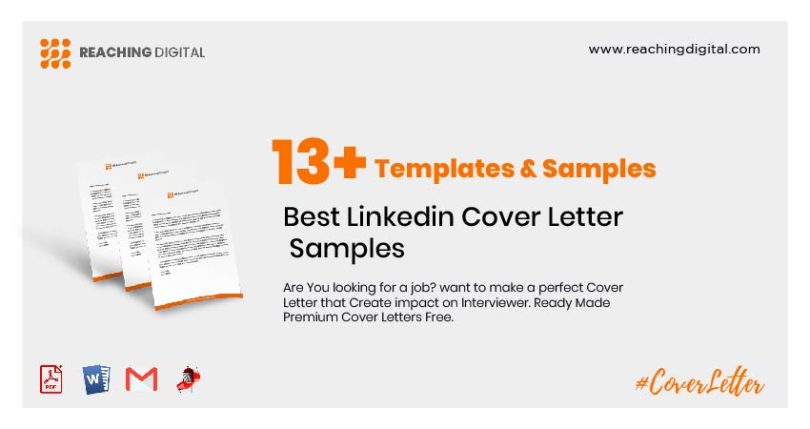
There’s no doubt that a great LinkedIn profile can open doors for job seekers. But did you know that a well-written LinkedIn cover letter can be just as important?
A LinkedIn cover letter is a chance to capture the attention of potential employers and stand out from the competition. And with more and more employers using LinkedIn as a recruiting tool, it’s important to know how to write a cover letter that will get noticed.
Fortunately, we’ve got you covered. In this article, we’ll share some of the best LinkedIn cover letter samples to help you get started. From there, you can start tailoring your own cover letter to fit your needs. So what are you waiting for? Let’s get started!
How To Write a Linkedin Cover Letter?
LinkedIn can be a powerful tool for networking and job searching. Many employers use LinkedIn to post job openings and reach out to potential candidates. And while you don’t necessarily need a cover letter when applying for a job on LinkedIn, including one can help you to stand out from the competition.
Here are some tips for writing a LinkedIn cover letter:
- Keep it short and sweet. Just like with any other type of cover letter, you don’t want to ramble on or include unnecessary information. Be concise and to the point.
- Use keywords. Take a look at the job listing and include some of the same keywords in your cover letter. This will help your application to be found by recruiters using LinkedIn’s search function.
- Highlight your skills and experience. In your cover letter, be sure to mention any relevant skills or experience that make you a good fit for the position. If you have a personal connection to the company, this is also a great opportunity to mention it.
- Use rich media. LinkedIn allows you to include rich media in your cover letter, so take advantage of this! You can upload images, videos, or even presentations that showcase your skills and experience.
- Proofread carefully. As with any written communication, it’s important to proofread your cover letter carefully before hitting “send” or “apply.” A few typos could give the impression that you’re careless or not taking the application process seriously. following these simple tips, you can write a powerful LinkedIn cover letter that will help you get noticed by potential employers. So go ahead and give it a try!
Related: How To Write a Cover Letter (And Get Hired in 2022!)
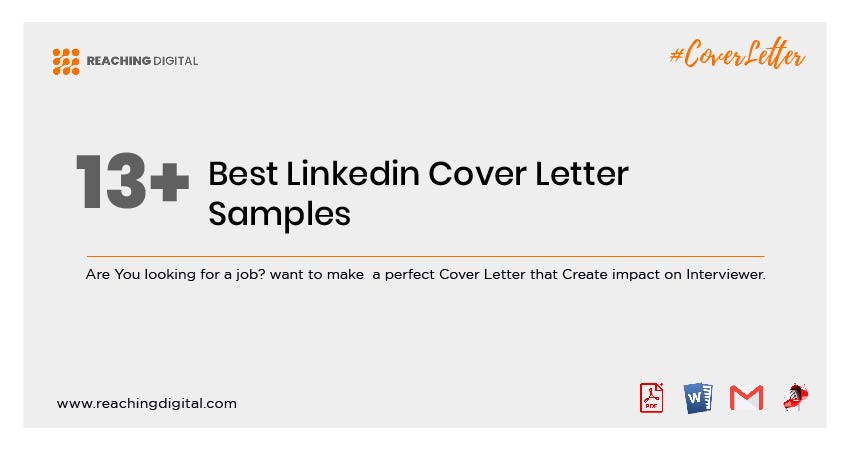
Linkedin Easy Apply Cover Letter
To Whom It May Concern,
I am writing to apply for the position ofXYZ that I saw on LinkedIn. I believe that my skills and experience make me the perfect candidate for this role.
As a XYZ professional, I have a deep understanding of the XYZ process. I am able to quickly identify areas of opportunity and work with teams to develop solutions that drive results. In addition, I have experience leading XYZ initiatives and projects. My strong communication and project management skills have helped me to successfully navigate complex organizations and deliver on objectives.
The confident that I can be a valuable asset to your team. I am eager to utilize my skills and experience to help your organization achieve its goals. I look forward to discussing my qualifications in further detail.
Thank you for your time and consideration.
Related: 07 Professional MBA Cover Letter Samples [Free]
Cover Letter Examples Linkedin
My name is ________ and I am a recent graduate of ___________. I am interested in obtaining a position as a ___________ in your company. I am attaching my resume for your review and would appreciate any opportunity to discuss my qualifications with you further.
Related: 07 Best Networking Cover letter Samples
Cover Letter Template Linkedin
The writing to apply for the position of ___________ with your company. It is a ___________ with ___________ years of experience in the field. I am knowledgeable in ___________, ___________, and ___________. I have attached my resume and would appreciate if you could contact me for an interview at your earliest convenience. Thank you for your time.
Related: 9+ Best cover letter for retail job Samples & Templates
Cover Letter Sample Linkedin
I am writing to express my interest in the position of XYZ that you have posted on LinkedIn.
As a recent graduate of ABC University with a degree in XYZ, I believe that I have the skills and qualifications that you are looking for in a candidate. In addition to my academic achievements, I have also gained valuable experience through my internships with DEF Company and GHI Organization, where I developed my skills in XYZ.
I am confident that I can be a valuable asset to your team and contribute to the success of your organization. I am eager to put my skills and experience to work in a professional setting, and I believe that this position would be an excellent opportunity to do so.
Thank you for your time and consideration. I look forward to hearing from you.
Related: Indeed Cover Letter: 07 Templates and Samples
Cover Letter For Job Application Linkedin
I am writing to apply for the job of ___________ that I saw advertised on LinkedIn.
I have _____ years of experience in this field and I am confident that I have the skills and qualifications that you are looking for.
Some of my key strengths include:
- -Strong communication skills
- -Leadership qualities
- -Ability to work independently
- -Organizational skills
- -Creativity
I am a motivated individual who is always looking for new challenges. I am confident that I would be a valuable asset to your team and I look forward to the opportunity to learn and grow in this role.
If you have any questions, please do not hesitate to contact me at ___________.
Related: Best Application Letter for Job Vacancy: 09 Examples & Sample
5 Things To Include In a Linkedin Cover Letter
Although your profile photo and headline are the first things people see when they visit your LinkedIn profile, your cover letter is an important opportunity to make a good impression and stand out from the competition. So, what should you include in your cover letter? Here are five things to keep in mind:
- Your elevator pitch: Use your cover letter to briefly introduce yourself and explain why you’re interested in the position or company.
- Your key qualifications: Highlight your skills, experience, and achievements that make you a good fit for the role.
- Your connection to the company: If you have any personal or professional connections to the company, be sure to mention them in your cover letter.
- Your call to action: End your cover letter with a strong call to action, such as asking for an interview or requesting additional information.
- Your contact information: Include your email address and phone number so the employer can easily get in touch with you.
By following these tips, you can ensure that your LinkedIn cover letter makes a great first impression and gives you the best chance of being noticed by employers.
Related: What is Cover Letter? Complete Guide To Get any Job.
LinkedIn is the perfect place to find a job, and your cover letter is the best way to introduce yourself to potential employers. We’ve provided over a dozen templates of high-quality cover letters that you can use as a starting point for your own letter. We hope you found this blog helpful and that you will use these templates to write an amazing cover letter that stands out from the rest. Thanks for reading!
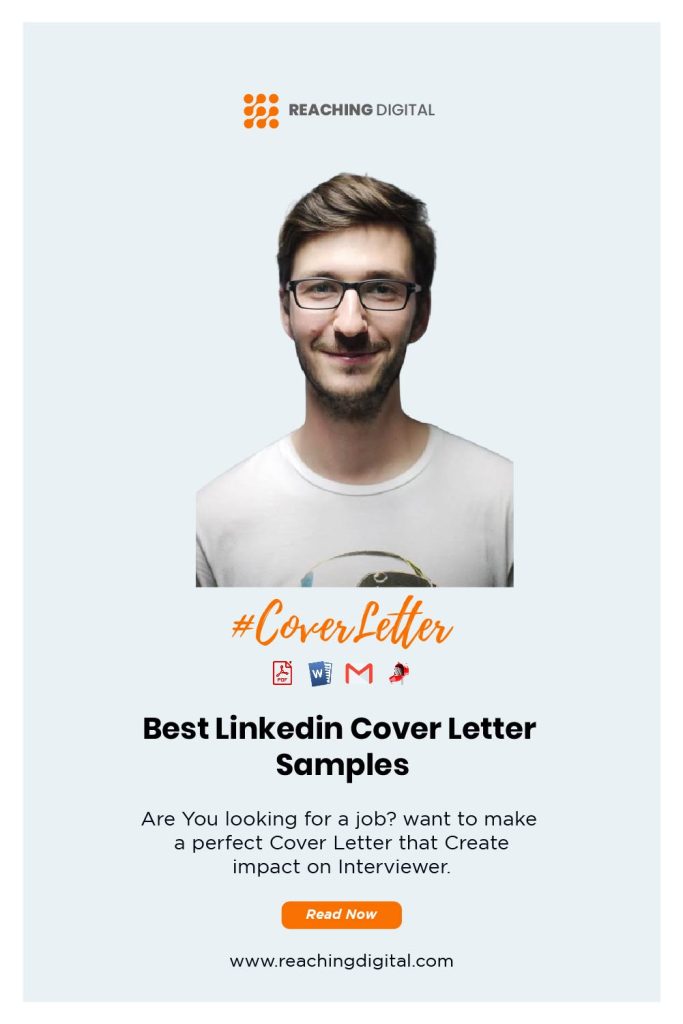
You may also like
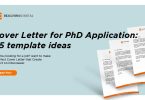
Cover Letter for Ph.D. Application: 5 Template ideas
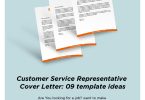
Customer Service Representative Cover Letter: 09...
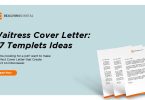
Waitress Cover Letter: 07 Template Ideas
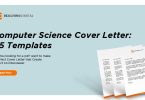
Computer Science Cover Letter: 05 Ready Template
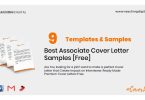
9 Best Associate Cover Letter Samples [Free]
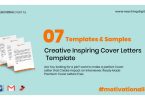
Creative Inspiring Cover Letters: 7+ Template
About the author.
Jessica William
Leave a comment x.
Save my name, email, and website in this browser for the next time I comment.
Protect your data
This site uses cookies and related technologies for site operation, and analytics as described in our Privacy Policy . You may choose to consent to our use of these technologies, reject non-essential technologies, or further manage your preferences.
- Career Advice
- What to Say When Emailing a...
What to Say When Emailing a Resume (with Examples)
10 min read · Updated on June 12, 2024

Introduce yourself professionally when you email your resume
You've written the perfect resume and tailored it to the role you're aspiring to. What should you do next? A few years back, you'd have printed it off on some quality paper, addressed an envelope in your best handwriting, posted it off, and settled in to wait for a response. These days, though, it's more common to email your resume. It's faster, it's more professional, and it's easier to share a file than a printout.
But if you're going to email your resume, what should you say? Should you attach a cover letter? How much detail should you include?
So many questions!
But fear not, TopResume is here to help you decide what to say when emailing a resume, and we have answers to all these questions and more. Settle in as we guide you through it.
Should I email my resume?
Yes! It's absolutely fine to email your resume when you apply for a job. In fact, it's usually preferred to printed correspondence these days. Of course, the most important point is that you should follow the instructions on the job posting. If it requests a printed resume or a resume uploaded via an online portal, you should definitely apply in line with those instructions. However, if there are no specific instructions, an email application is advisable. Just make sure you're addressing it to the right person!
General rules for emailing your resume
Before we get into the specifics, let's refresh on some general guidelines for emailing your resume to a company. After all, first impressions count, so using proper email etiquette is important.
Use a professional email address. “ HotLips69@...” may have seemed cool and funny when you set up the account, but does it really convey that you're a credible professional? If necessary, set up a new email account to use for job applications – and remember to check it regularly for responses!
Add a clear subject line. Make the point of your email clear with a logical subject line – you could include the job title of the vacancy you're applying for, for example, or refer to the fact that the email is a job application or resume.
Choose a professional greeting. Think “Dear [name],” or even just “[name],” rather than “Hiya” or “Greetings.” While email is less formal than a letter, you still need to keep the tone professional.
Be concise. Short, snappy paragraphs are easier to read on a screen, and no one wants to trudge through pages of waffle to find the information they need. Respect the reader's time by keeping it simple.
Add a formal sign-off. A version of “thank you” and your name is sufficient – you may also want to add your professional title, a contact number, and a link to your portfolio if you have one.
Don't forget the attachments! Make sure that you've actually attached your resume (and your cover letter, if required). Ensure they have sensible file names, too: “Jay Miller – Resume” or “J Miller – Sales Executive Resume” is more professional and easier to retrieve than something like “JM 010224 v3” or simply “Resume.” Also, double-check the file type that you're sending – check out our article Word vs PDF if you're not sure.
What to say when emailing your resume – the detail
So now we've reviewed the basics of email etiquette, let's get down to business. You need to know what to say when emailing a resume. Well, the exact wording will vary depending on the situation, the role, and your personality, but you'll certainly need to include the following:
Why you're emailing
Your reader may have a ton of open vacancies and is likely to receive many resumes for each one. Make their life easier by clearly stating the role you're interested in applying for. If you have a reference number for the vacancy, you can include that too.
Your elevator pitch
Briefly explain who you are , what you do, and why you're the right person for the open role. This doesn't need to take up a lot of space or be very detailed – the key thing here is to be convincing enough for them to want to open your resume document to find out more. Include whatever information is most pertinent to the role – that could be your academic qualifications, your industry experience, awards and accolades, or particular skills. Refer to the job posting to find out what the company wants to see in a successful candidate and ensure the requirements are reflected in your email.
A call to action
Encourage the reader to open your resume, reach out with further questions, or schedule an interview. This one little line can show your enthusiasm for the role, emphasize your professionalism, and prompt your reader to take the next step in progressing your application.
What to say when emailing a resume – sample messages
Do you need a bit more inspiration to craft your message? Take a look at these sample emails and use them as a frame for your own resume email. Remember, the job advert is your cheat sheet when it comes to deciding what details to prioritize here.
What to say when cold emailing a resume
To: Katie French
From: Matthew Cole
Subject: Sales resume
I've long admired XYZ Inc. as a leading supplier of home tech solutions and have heard many positive reviews about your company as an employer. To that end, I am attaching my resume in the event that a sales vacancy may soon arise.
As you can see, I have enjoyed a successful 10-year career in technology sales and am a committed user and advocate of your products. This year, I am on track to exceed my sales target by 46%. I would bring an extensive network of industry contacts and a proven ability to motivate sales teams to surpass expectations.
If there are no suitable vacancies at the moment, please feel free to keep my resume on file for future reference. I look forward to hearing from you soon.
Matthew Cole
Sales Manager, Acme Products
What to say when emailing a resume in response to a job posting
Subject: Sales Executive vacancy (Ref: ABC123)
In response to your advertisement for a Sales Executive, I am attaching my resume. As you can see, I combine eight years of sales experience with a degree in Marketing and three awards for excellence in sales roles.
The advertised role is particularly interesting to me, as it will allow me to leverage my expertise in technical sales, provide the opportunity for international growth, and establish trusted relationships with your clients to open new avenues for revenue and increased sales.
Please don't hesitate to reach out to me if you have any questions; I look forward to discussing my suitability further with you at an interview.Thank you for your consideration,
Sales Executive, Acme Products
What to say when emailing a resume to a recruiter
Subject: Healthcare Roles
Dear Katie,
I saw on JobBoard.com that you are recruiting for several healthcare roles, and would like to submit my resume for your consideration. I combine 10 years' experience as a Healthcare Assistant with numerous industry certifications and consistently receive positive patient feedback.
I look forward to hearing from you,
What to say when emailing a resume to follow up on a conversation
Subject: Finance Manager follow-up
Following our phone discussion earlier today, I would like to reiterate my interest in the Finance Manager position and attach my resume for your consideration.
As you can see, I am currently fulfilling the Finance Manager role at XYZ Company and am looking forward to developing my career within a global organization. I have a master's degree in Business Administration, as well as extensive experience in managing the finance function within a security business. I look forward to bringing my leadership skills to your team of finance experts.
Please reach out to me at 555-555-5555 when you have had a chance to review my attached resume.Regards,
Finance Manager, XYZ Company
What to say when emailing a resume following a referral
Subject: Events Manager vacancy
Dear Ms French,
Please find attached my resume. I have been referred to the Events Manager position by one of your colleagues, John Day, who I previously worked with at ABC Inc. Having delivered many successful events with John as my manager, I'm flattered that he has now asked me to apply for your open role.
I've recently delivered a conference for 800 international delegates and a team building event for 5 national teams, both of which were very well received and were completed within challenging budgets. I am confident that I can bring a similar level of client satisfaction to DEF Inc. and look forward to discussing the position further with you.
Please don't hesitate to get in touch to schedule an interview at your convenience,
555-555-5555
Should you attach a cover letter when emailing a resume?
Now we've covered what to say when emailing a resume, it's time to consider the cover letter. As you can see, we recommend that the body of the email be kept short and concise. If you feel the need to include more detail, you can consider attaching a cover letter as well as a resume. There's no obligation to do this unless a letter is specifically requested as part of the application instructions, but it does give you the opportunity to expand on key points of interest.
Top tip: You may like to read our article on how to write a cover letter to make sure you get this part of your application bang on!
How long does it take to hear back after emailing a resume?
Don't panic if you don't hear back immediately! While email is a speedy way to apply, recruiters and hiring managers receive many resumes for every open role and need time to sift through them, create shortlists, and schedule interviews. That said, certain recruiters have a reputation for ghosting unsuitable candidates, or your application may simply have been overlooked, so there's no harm in following up after a week or two if you haven't heard anything.
What to write in a follow-up email
Subject: Communications Assistant vacancy (ref: 12345)
I emailed my resume to you last week in response to your advertisement for a Communications Assistant. I just wanted to check that you'd received it, and to reiterate that I remain very interested in the role.
If you didn't receive the resume or have further questions regarding my application, please do get in touch with me either via email or by phone at 555-555-5555.
Email with confidence
Now you know what to say when emailing your resume in any situation, you're ready to apply for your dream job! Use this checklist to make sure you've nailed it before you hit the send button:
Correct email address and personalized greeting
Appropriate subject line
Clarification of the role you're applying for
Elevator pitch
Call to action
Professional sign-off
Attachments attached
Final proofread
If you feel that your resume isn't quite ready to be unleashed upon the world, why not get an expert opinion? Our free resume review will explain which areas need further work before you submit your application.
Recommended reading:
How to Write the Perfect Goodbye Email to Co-Workers & Clients
The Networking Email That Works Every Time
How To Use AI To Prepare For A Job Interview
Related Articles:
Guide to Writing a Great Resume with No Work Experience
How To Write a Sick Leave Letter (with Template and Example)
Resume Mistakes: Red Flags Employers Are Looking For
See how your resume stacks up.
Career Advice Newsletter
Our experts gather the best career & resume tips weekly. Delivered weekly, always free.
Thanks! Career advice is on its way.
Share this article:
Let's stay in touch.
Subscribe today to get job tips and career advice that will come in handy.
Your information is secure. Please read our privacy policy for more information.
Are you seeking one-on-one college counseling and/or essay support? Limited spots are now available. Click here to learn more.
How to Write a Cover Letter – Template and 9 Expert Tips
July 19, 2024

If you’re applying for a job, you’ll most likely need to prepare a polished résumé, to practice common interview questions , to request recommendations and references , and to write a cover letter. There are many types of cover letters out there. These include the application cover letter, the prospecting cover letter, and the career change cover letter. In this article, we’ll discuss the most common: the application cover letter, which is what you’ll need when trying to secure a new job (usually for a currently open position). Below, we’ll recommend how to write a cover letter (including how to end a cover letter) and provide a cover letter template to help you get started!
If you like our template and tips you may also want to view our 3 Great Cover Letter Examples for Any Job .
While we can provide a cover letter template to serve as a skeleton for your writing, you’ll need to flesh out your work with important details that are relevant to you, your experiences, and the prospective job at hand. As you begin drafting these details, it’s important to remember a few essential moves that are crucial as you learn how to write a cover letter:
1) Do your research
Before you send a cover letter to an employer, it’s imperative that you have a thorough understanding of the position you’re applying for , the job’s expectations and requirements, your future role within the hierarchy of the workplace, and the overall company culture. Knowledge of these items will help you determine which of your relevant skills and accolades you should include in your letter, the person or people to whom you should address your writing, and the tone and style of your cover letter. It will also help you decide what to leave out of your cover letter. Remember to only stick to items that are relevant to the position at hand!
2) Make particular connections
Use specificity when listing your accomplishments and describing your goals. Just as importantly, describe how you as a candidate are uniquely positioned to fill this position successfully. For instance, a general and less-connected sentence might say, “I have strong leadership skills.” But a detailed, job-specific sentence might be, “As a project manager for Waterscapes, I oversaw a team of twelve employees working on the development and implementation of River Clean Up 2024, which reduced plastic waste in our local water systems by 27%. This experience will inform my future work with your company as an Assistant Director of Eco-Initiatives.”
Think of each sentence as an opportunity to illustrate potential links between your previous work and your future career. Just like answering a “ tell me about yourself ” question in an interview, this is a moment to describe your past, present, and now your future in your hoped-for job.
How to Write a Cover Letter – Cover Letter Template (Continued)
3) add well-considered details.
Does your prospective job’s company have a strong online presence? Does your future employer have a LinkedIn profile that lists publications, affiliations, or specific awards and accolades? Do you have a personal connection with your employer or someone important at the company? If so, now is the time to utilize some of your social capital and make mention of these items. Doing so adds a personal touch and makes your cover letter more memorable. It also demonstrates your willingness to research and promote the company’s culture.
For instance, if you’re applying for a position at a language-learning app company and their motto is, “Communication for All,” this specific phrase could be used as you describe your passion for making language-learning accessible, regardless of the student’s background or income.
4) Be professional
Depending on the job for which you’re applying, your overall cover letter tone may vary. If you’re applying for a job as a copywriter for a quirky astrology start-up, you might be able to include fun details about horoscopes in your cover letter. If, on the other hand, it’s a position for a tenure-track professor job at a top research university, your tone will be much more formal and will include particulars about your contributions to the field.
Regardless of the job, you should always utilize a professional font (no Comic Sans!) and clear letterhead for readability to convey your seriousness about the position. You should also always try to convey sincerity in your writing. Additionally, make sure your reader knows you really want this job and will do your best at it if you’re hired.
5) Be confident!
Now is not the time to focus on your professional faults or limitations. Now is the time to promote yourself with abandon. Focus on your relevant work experience, your strengths, your accolades, and your willingness to learn and grow in this new job.
6) Brainstorm and draft
Do not rush your cover letter! This is a professional genre of communication that signifies your intentions to advance your career. It should be treated as a formal record of your employment history. As such, spend time cultivating your writing and trimming it so that it is rich, informative, candid and attractive.
Drafting also includes editing details like spelling and grammar checks – it has long been established that simple errors and problems with writing organization can cause employers to not take your work seriously. [i] Other small details can indicate your level of seriousness about yourself and this work. [ii] For instance, if you have a personal email address like “ [email protected] , you may want to think of creating and using a separate email address that is a little more professional, like “ [email protected] .”
7) Be direct
At all points in your cover letter, it’s essential to start with the punchline. Studies have demonstrated that readers and listeners often retain the first sentence of a paragraph or presentation before their attention starts to wane. [iii] As such, beginning with your main point and following with examples to support that point is the best way to grab your reader’s attention and ensure they fully absorb your meaning.
8) Pay attention to length
How long should a cover letter be? In most cases, a cover letter should not exceed one page of single-spaced writing (about 250 to 400 words, max). Remember that your prospective employer may be reading dozens of cover letters. He or she will probably not have the time nor inclination to read an unnecessarily long cover letter.
9) Finish on a promising note
As you consider how to end a cover letter, it’s important to focus on positivity and continuing dialogue with your prospective employer. Gesture toward future communication with closings like, “I look forward to your response,” or “I look forward to sharing more with you about my previous experience and qualifications for this position.”
Is it okay for me to use this cover letter template?
As you sit down to brainstorm how to write a cover letter, you may be wondering: How can I be original if I’m using a template? Aren’t I just copying what someone else has written? In short, the answer is: you can definitely use a cover letter template because templates are simply great starting points! You aren’t copying the content of the cover letter template. Rather, you are using the frame of the cover letter template to create your own original writing.
Templates are generative, meaning they are simply a beginning or prompt for your own writing and ideas to grow and flourish. Templates help you make writing moves you might not have otherwise considered. In the case of a cover letter template, using a model can be inspirational, helping you remember important details about your résumé and other job-related skills you may have forgotten. Finally, templates can combat writer’s block and help you organize your ideas into a coherent cover letter. Ultimately, “the aim of templates is not to stifle critical thinking but to…be direct about the key rhetorical moves” necessary for a piece of writing. [iv]
Below, you’ll find a cover letter template to get you started. Good luck!
Cover Letter Template
[ Your name ]
[ Your phone number ]
[E mail address ]
[ Optional: Your mailing address – you usually only need to include this if it’s a printed cover letter or if the employer will not be contacting you via email or phone. ]
Dear [ specific title and name of application recipient ],
As a [ your professional title ] with [ number ] years’ experience in [ field ], I am applying for the position of [ job title ]. To this position, I would bring [ highlight the 1-3 most important ways you will bring your specific skills to this job to benefit, develop, and serve the company or employer ].
[Body Paragraph 1: Using the skills you mention at the beginning of the letter, find 1-2 relevant, concrete examples from your previous work experiences to demonstrate how you’ll be a good fit for this new job ].
Because of [ skill or experience listed in first paragraph ], I can facilitate [ your company ] with [ specific requirement listed in the job description ]. Furthermore, my previous work with [ specific skill ] can additionally help [ specific job requirement ].
[Body Paragraph 2: Using the skills or experiences mentioned at the beginning of the letter, demonstrate how your current work will make you a good candidate for this job .]
In my current position as [ job title ] at [ current place of work ], I [ list specific responsibility with detail ] and am eager to continue to grow professionally at [ your company ] with [ similar work that will be required at this new job ]. At [ your company ], [ insert specific detail about the company culture, job requirements, or general news about the company ], I am eager to use my current skills as a [ insert your experience ] to help expand this work.
[Body Paragraph 3: Using the skills and experiences mentioned at the beginning of the letter, demonstrate how you hope to grow as a worker in this new position ].
I have always seen myself as a [ particular job title or responsibility ] and to be afforded the opportunity to do so at a company as prestigious as [ company name ], will let me develop [ specific professional skills ] while promoting the company’s mission to [ include part of the company’s mission ].
I am available to answer any questions you may have about my résumé or previous work experiences. Please don’t hesitate to reach out. Thank you so much for your time and consideration. I look forward to your response.
[ Your Name ]
How to Write a Cover Letter with Template – Works Cited
- [i] McDowell, Earl E. “Perceptions of the Ideal Cover Letter and Ideal Resume,” Journal of Technical Writing and Communication. Volume 17, Issue 2, April 1987.
- [ii] Martin-Lacroux, Christelle, and Alain Lacroux. “Do Employers Forgive Bad Spelling in Resumes?” Business and Professional Communication Quarterly, Volume 80, Issue 3. 26 October 2016.
- [iii] Garner, Joanna K. and Michael P. Alley. “How the design of presentation slides affects audience comprehension: A case for the assertion-evidence approach,” International Journal of Engineering Education . Vol. 29, Issue 6, 2013.
- [iv] Graff, Gerard, and Cathy Birkenstein. They Say / I Say: The Moves That Matter in Academic Writing . W.W. Norton & Company, New York, 2006.
How to Write a Cover Letter with Template – Additional Resources
- How to Send a Condolence Message for a Coworker (with Samples)
- 25 High Paying Work from Home Jobs
- How to Tell Your Boss You’re Quitting
- How to Answer “Tell Me About Yourself” with Examples
- Resignation Letter Samples
- 25 Job Interview Questions and Answers
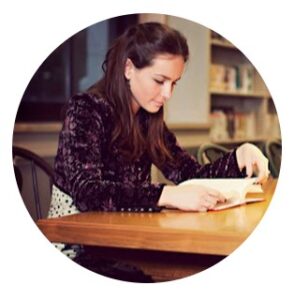
Jamie Smith
For the past decade, Jamie has taught writing and English literature at several universities, including Boston College, the University of Pittsburgh, and Carnegie Mellon University. She earned a Ph.D. in English from Carnegie Mellon, where she currently teaches courses and conducts research on composition, public writing, and British literature.
- 2-Year Colleges
- Application Strategies
- Best Colleges by Major
- Best Colleges by State
- Big Picture
- Career & Personality Assessment
- College Essay
- College Search/Knowledge
- College Success
- Costs & Financial Aid
- Data Visualizations
- Dental School Admissions
- Extracurricular Activities
- Graduate School Admissions
- High School Success
- High Schools
- Homeschool Resources
- Law School Admissions
- Medical School Admissions
- Navigating the Admissions Process
- Online Learning
- Outdoor Adventure
- Private High School Spotlight
- Research Programs
- Summer Program Spotlight
- Summer Programs
- Teacher Tools
- Test Prep Provider Spotlight

“Innovative and invaluable…use this book as your college lifeline.”
— Lynn O'Shaughnessy
Nationally Recognized College Expert
College Planning in Your Inbox
Join our information-packed monthly newsletter.
I am a... Student Student Parent Counselor Educator Other First Name Last Name Email Address Zip Code Area of Interest Business Computer Science Engineering Fine/Performing Arts Humanities Mathematics STEM Pre-Med Psychology Social Studies/Sciences Submit
- Develop Resumes, CVs & Cover Letters
- Search for a Job or Internship
- Explore Majors & Careers
- Prepare for an Interview
- Prepare for Graduate School
- Expand My Network
- Research Salaries & Negotiate Offers
- Enroll in the Cooperative Education Program
- Grow in Core Competencies
- Visit the Career Closet
- Reserve an Interview Room
- View Recorded Workshops
- Undergraduate Students
- Graduate Students
- First Year Alumni
- First-Generation Students
- Students with Disabilities
- International Students
- Accounting & Finance
- Agriculture, Food & Natural Resources
- Architecture & Construction
- Arts, Audio/Video Technology & Communications
- Business Management & Administration
- Education & Training
- Engineering & Technology
- Government & Public Administration
- Health Science
- Hospitality & Tourism
- Human Services
- Information Technology
- Law & Policy
- Operations & Logistics
- Science & Mathematics
- Career Services
- Cooperative Education Program
- On-Campus Internships (UPIC)
- Off-Campus Internships
- International Internship Program
- Internship Prep Program | Tigers on Track
- Corporate Partners
- Faculty & Staff
- Parents & Families
- Mission & Vision
- Meet the Team
- Outcomes & Data
- Visit the CCPD
- Frequently Asked Questions
- Clemson University Home
Cover Letter Packet
- Share This: Share Cover Letter Packet on Facebook Share Cover Letter Packet on LinkedIn Share Cover Letter Packet on X
A cover letter is your introduction to an employer. In this letter, you should briefly describe your interest in the position and summarize your qualifications.
Recommendation Letter for Internship: Examples and What Makes a Good One

Early in your career, resumes often don't say much (we've all been there). But with a strong recommendation letter, you'll have the evidence you need to showcase your skills and make your application shine. Yes, you could be one recommendation letter away from landing your dream internship .
A recommendation letter for an internship shows the hiring team that you're serious about the position and willing to go the extra mile to prove you're a good fit. “These letters offer glimpses into a candidate's capabilities beyond what resumes or academic records may reveal,” says Jarir Mallah, Human Resources Manager at the tech company Ling .
We reunited the best tips from human resources professionals, team leaders, and even a generative AI specialist to give you the ultimate guide on how to write an internship recommendation letter.
What is an internship recommendation letter?
An internship recommendation letter is a document that serves to endorse someone based on their personal character or academic performance. It is typically written by a person who knows the candidate well, such as a professor, mentor, or previous employer, and it details the applicant's qualifications, skills, and potential to excel in a professional setting.
“That being the case, the testimony that a candidate has certain hard and soft skills is not met with some second guessing”, says Martin Gasparian, owner of the law firm Maison Law who frequently conducts internship interviews. “As it's written by a highly respected person, I don't have any problem trusting it.”
A strong internship reference letter fills in the gaps that an entry-level candidate's resume might have. It provides personal insights that only firsthand observations can offer, significantly enhancing their appeal to potential employers.
What to include in an internship reference letter?
An outstanding internship recommendation letter focuses on real-world examples so the hiring team can envision how your abilities manifest on a practical level. It can include academic achievements and personal projects, for example.
“A recommendation letter for an internship should corroborate your skills, character, and potential, and confirm your ability to adapt, learn, and contribute in a professional environment,” Mallah says. “It should be specific about strengths , connect these skills to potential contributions you may bring to the role, and share instances where these skills have shone through.”
Put that recommendation letter to work — check out open jobs on The Muse and land your next interview »
How many letters of recommendation do you need for an internship?
The exact number depends on the company you’re applying to, but it’s common to be asked for one to four letters of recommendation. Always check the specific requirements in the internship application—or the recruiter might tell you during the interview process . Sending multiple letters can give a well-rounded view of your skills and character, but ensure each one offers a unique perspective.
How to ask for a recommendation letter
Follow these steps on how to choose the right person to write a recommendation letter and approach them appropriately.
1. Choose the person wisely
Approach someone who knows you well and can speak to your strengths, work ethic, and character. This could be a professor or a mentor who has observed your skills and performance over time. Make sure they have a positive view of your abilities and are in a position to give you a strong endorsement.
2. Ask politely and plan ahead
Writing a recommendation letter takes time, and a polite request shows your appreciation for their effort. Approach the person respectfully and provide ample time for them to write the letter—ideally a few weeks before the deadline.
3. Provide background information
Help the chosen person to write a detailed and relevant letter by giving them information about the internship, your resume, and a summary of your accomplishments and goals. Remind them of specific projects or experiences you’ve shared to help them craft a more personalized and impactful letter.
Recommendation letter for internship: Examples
Having concrete examples can be incredibly helpful in guiding someone on how to write one for you. We compiled some recommendation letter examples tailored to different fields to serve as inspiration and ensure you know exactly what you're asking for.
Marketing internship recommendation letter: Example #1
Dear Recruiter/Hiring Manager/Hiring Team,
I am writing to recommend [Your Name] for the marketing internship at [Company Name]. As [Your Position/Title] at [Your University/Organization], I have had the pleasure of working with [Your Name] for [Duration], during which time they have demonstrated exceptional creativity, strategic thinking, and a strong work ethic.
One of [Your Name]’s notable projects involved developing a social media campaign that increased our engagement by 35% in just two months. Their ability to analyze market trends and craft compelling content is impressive and speaks volumes about their potential in the marketing field.
I am confident that [Your Name] will be an asset to your team and excel in the marketing internship role at [Company Name]. Please feel free to contact me if you need further information.
Sincerely, [Your Recommender’s Name] [Your Recommender’s Title] [Your Recommender’s Contact Information]
Finance internship recommendation letter: Example #2
It is my pleasure to recommend [Your Name] for the finance internship position at [Company Name]. As [Your Title] at [Your University/Organization], I have closely observed [Your Name]’s academic and professional growth over the past [Duration].
[Your Name] has consistently shown a keen understanding of financial principles and a knack for detailed analysis. During their time with us, they successfully led a team in a financial modeling project that resulted in a 15% cost reduction for a simulated company scenario. Their analytical skills, combined with their teamwork and leadership abilities, make them a standout candidate for this internship.
I wholeheartedly endorse [Your Name] for the finance internship and believe they will bring valuable insights and energy to your organization.
[Your Recommender’s Name] [Your Recommender’s Title] [Your Recommender’s Contact Information]
Engineering internship recommendation letter: Example #3
I am pleased to recommend [Your Name] for the engineering internship at [Company Name]. As [Your Position/Title] at [Your University/Organization], I have had the opportunity to supervise [Your Name] in several engineering projects over the past [Duration].
[Your Name] possesses exceptional problem-solving skills and a strong foundation in engineering principles. One of their significant contributions was in a collaborative project where they developed an innovative solution to optimize the efficiency of a mechanical system, leading to a 20% improvement in performance.
Their dedication, technical expertise, and ability to work well in a team environment make [Your Name] an ideal candidate for your engineering internship program. I am confident that they will excel in this role and contribute positively to your team.
Internship recommendation letter template
Not quite there yet? Here's a template you can use to streamline the process.
I am writing to recommend [Your Name] for the [Internship Position] at [Company Name]. As [Your Recommender’s Position/Title] at [Your University/Organization], I have had the pleasure of knowing [Your Name] for [Duration]. During this time, [Your Name] has demonstrated exceptional [skills/qualities], including [specific example or project].
[Your Name] has consistently shown [positive traits such as leadership, creativity, and dedication], which makes them an excellent candidate for the [Internship Position] at [Company Name]. Their [specific skills or experiences] have prepared them well for this opportunity, and I am confident they will excel in this role.
Please feel free to contact me if you need further information.
Make your mark in a process dominated by AI
The more internship testimonial letters, the easier the interview process.
We get it—a lack of experience can make you nervous and feel less prepared compared to other candidates. However, having recommendation letters for internships from established professionals can really boost your chances. These letters can be instrumental in helping employers make informed decisions. So yes, it's definitely worth it!
Once you've got that interview, check out our 30+ Best Tips on How to Prepare for a Job Interview
Hey job seekers — hiring managers are onto your ChatGPT-written applications
- Job seekers using AI-generated applications face detection and potential rejection by employers.
- Companies note an uptick in AI-written job applications, complicating the hiring process.
- Experts suggest customizing AI assistance to stand out — using it as an editor instead of a writer.

If you're hoping to use ChatGPT to get a leg up on job applications, you might just be shooting yourself in the foot.
While companies have been leveraging AI to automatically weed out résumés, job seekers have begun responding with chatbot-generated applications to keep up — and employers are noticing.
Jakob Knutzen, cofounder and CEO of video collaboration platform Butter, said he received around 450 applicants for a product designer position. But Knutzen told Business Insider he was able to detect what he believed was ample usage of ChatGPT-written responses to the form's three questions.
"The formulations were incredibly similar and used a bunch of phrases that I would never imagine people using," he said.
When Knutzen took his concerns to a LinkedIn post , other employers reported seeing a similar trend of a spike in AI-written job applications.
Christina Hallman, who is head of demand generation for cybersecurity risk management company Outpost24, recently said she received over 250 applications for two open positions.
She told Insider she estimated that 45% of the optional cover letters were AI-generated.
"I went over to ChatGPT and I put in our live job posting, and I said give me a cover letter," Hallman told Insider. "And it spit out almost the identical template that I was receiving time and time again."
She said that it didn't necessarily eliminate the candidate from the running, but when it came down to choosing between an application that used a ChatGPT-generated cover letter and a similar one that didn't, the latter would be hired.
"It just ended being like, well, it's not helping you," she said. "It's better to have just not attached anything."
Related stories
Hallman, who said she has a decade of hiring experience, said that she's seen a noticeable increase in the use of AI in applicants over the past one to two years.
And it's likely going to keep climbing as ChatGPT and other AI tools become more accessible — and popular.
A 2023 study conducted by iCIMS found that 47% of college seniors were interested in using ChatGPT or other AI bots to write their résumé and cover letters, while 25% of Gen Z who were surveyed said they already have.
Some recruiters have considered creating "AI-proof" questions, such as requiring an introductory Loom video. Others have even set chatbot traps by sneaking hidden instructions for LLMs that show up in the applicant's response.
Although Knutzen said his company did contemplate using videos or other questions that could cut down on the likelihood of AI-generated responses, they decided against it due to concerns that the "barrier for entry would be too high."
However, some comments under Knutzen's post said that job seekers were simply leveling the playing field with recruiters — especially with an increasingly tough job market .
One person wrote, "When companies use automated systems to decide who is worthy of an interview, what do they expect applicants to do?"
Over 97% of Fortune 500 companies use automated hiring systems , according to a 2023 study conducted by Jobscan.
"I think it's more of a frustration with the application process overall," Knutzen said. "I don't think that companies are respecting the process for applicants."
Knutzen, who said his company does not use ATSs, points out that many companies tend to ghost candidates or send an automated rejection, which can discourage job seekers.
"If you don't get a lot of feedback on the applications that you send, then you begin thinking that they don't matter," he said. "If the company doesn't think it's important, why should I?"
However, Knutzen stresses that the issue isn't necessarily the use of AI but rather using it "as a writer and not an editor."
Hallman said she "fully expects" people to use AI in their jobs and applications to save time, but she warns candidates against relying on it blindly.
"It's not the use of AI that's the problem, it's the lack of customization that is coupled with it," Hallman said. "If you're going to use AI, I think you need to use it really intentionally."
She said that applicants using the same chatbot-written responses become lost among their identical competitors.
"You need to have that human checkpoint," Hallman said. "Or it will just be a sea of everyone spitting out the same thing."
Watch: Volkswagen is using AI to speed up and scale marketing, while also integrating ChatGPT into its vehicles, says CMO Susanne Franz
- Main content

Helping our customers through the CrowdStrike outage
Jul 20, 2024 | David Weston - Vice President, Enterprise and OS Security
- Share on Facebook (opens new window)
- Share on Twitter (opens new window)
- Share on LinkedIn (opens new window)
On July 18, CrowdStrike, an independent cybersecurity company, released a software update that began impacting IT systems globally. Although this was not a Microsoft incident, given it impacts our ecosystem, we want to provide an update on the steps we’ve taken with CrowdStrike and others to remediate and support our customers.
Since this event began, we’ve maintained ongoing communication with our customers, CrowdStrike and external developers to collect information and expedite solutions. We recognize the disruption this problem has caused for businesses and in the daily routines of many individuals. Our focus is providing customers with technical guidance and support to safely bring disrupted systems back online. Steps taken have included:
- Engaging with CrowdStrike to automate their work on developing a solution. CrowdStrike has recommended a workaround to address this issue and has also issued a public statement. Instructions to remedy the situation on Windows endpoints were posted on the Windows Message Center .
- Deploying hundreds of Microsoft engineers and experts to work directly with customers to restore services.
- Collaborating with other cloud providers and stakeholders, including Google Cloud Platform (GCP) and Amazon Web Services (AWS), to share awareness on the state of impact we are each seeing across the industry and inform ongoing conversations with CrowdStrike and customers.
- Quickly posting manual remediation documentation and scripts found here .
- Keeping customers informed of the latest status on the incident through the Azure Status Dashboard here .
We’re working around the clock and providing ongoing updates and support. Additionally, CrowdStrike has helped us develop a scalable solution that will help Microsoft’s Azure infrastructure accelerate a fix for CrowdStrike’s faulty update. We have also worked with both AWS and GCP to collaborate on the most effective approaches.
While software updates may occasionally cause disturbances, significant incidents like the CrowdStrike event are infrequent. We currently estimate that CrowdStrike’s update affected 8.5 million Windows devices, or less than one percent of all Windows machines. While the percentage was small, the broad economic and societal impacts reflect the use of CrowdStrike by enterprises that run many critical services.
This incident demonstrates the interconnected nature of our broad ecosystem — global cloud providers, software platforms, security vendors and other software vendors, and customers. It’s also a reminder of how important it is for all of us across the tech ecosystem to prioritize operating with safe deployment and disaster recovery using the mechanisms that exist. As we’ve seen over the last two days, we learn, recover and move forward most effectively when we collaborate and work together. We appreciate the cooperation and collaboration of our entire sector, and we will continue to update with learnings and next steps.
- Check us out on RSS

IMAGES
VIDEO
COMMENTS
After reviewing the benefits of a cover letter versus a LinkedIn profile, you've probably realized that they have different uses. While a cover letter helps enhance your application, a LinkedIn profile establishes an online presence that expands your reach to hiring managers who may only be searching through that platform. Not all employers ...
A cover letter is an introductory document many employers ask you to submit along with your resume when applying for a job. Depending on the company, you might need to email your cover letter and resume or there may be an online application process where you can upload it. Many job listings specify if they require a cover letter, but some don't ...
1. Make sure your LinkedIn profile is 100% complete BEFORE you apply. The first thing a recruiter will do after they receive your Easy Apply app is look at your LinkedIn profile. Before you start applying to jobs, you need to make sure your profile is up to date and accurate AF. In other words, your profile picture should be on point, and all ...
Yes, you do need a cover letter in these common situations: The job description requests or requires a cover letter. You have a referral for your cover letter. The job requires strong writing and communication skills. Even if the job description says "cover letter optional", it's still important to write a great cover letter and attach it ...
The cover letter is a contender for job seekers' most hated part of the job search. Personally, when browsing job boards, I've always gravitated toward the postings that said "cover letter optional" or didn't mention one at all—and I'm a writer.When you're deep in a job hunt—particularly one where you feel like you're throwing applications into a black hole—cover letters ...
Step 3: Address your cover letter to the hiring manager—preferably by name. The most traditional way to address a cover letter is to use the person's first and last name, including "Mr." or "Ms." (for example, "Dear Ms. Jane Smith" or just "Dear Ms. Smith").
Include a call to action. This is one way writing a LinkedIn cover letter aligns with the conventional wisdom found in many cover letter articles. Make sure to end your cover letter with a clear prompt for the person reading it to take the next step in the hiring process. Reiterate your enthusiasm and invite them to view any materials or ...
2. Enter a job title or job keywords into the search bar. Next, enter basic search terms into LinkedIn's search box at the top of the screen. You could search for a job title like, "Software Engineer" or "Sales Manager". That's how I recommend starting. 3. Use LinkedIn's job search filters to narrow your search.
Middle paragraph (s) Closing paragraph. Letter ending and signature. Your cover letter should be one page long and use a simple, professional font, such as Arial or Helvetica, 10 to 12 points in size. Your letter should be left-aligned with single spacing and one-inch margins. Show Transcript.
Step 1: Connect your LinkedIn profile to the LinkedIn optimizer tool. Step 2: Upload your LinkedIn profile as a PDF file to the tool. Step 3: Paste in at least three job descriptions into the tool for best results. Step 4: Once you click "Scan" a LinkedIn Report will be generated.
Here are some benefits of including a cover letter in your job application: 1. They showcase your personality. Cover letters typically reveal insights into a candidate's values, character traits and outlook on work. Many hiring managers prefer candidates who align with the organization's culture, so highlighting your unique personality in your ...
1. Personalization. Address the hiring manager or recruiter by name whenever possible. If the job posting doesn't include a name, research to find out who will be reviewing applications. Personalizing your cover letter shows that you've taken the time to tailor your application to the specific company and role. 2.
There are three main types of cover letters: Application cover letters are the most common type. These are sent together with resumes to apply for a particular job opening. Referral cover letters indicate a mutual contact you share with a recruiter. It might be an industry expert or an employee at the company where you are applying.
We'll see in this video, You can put your cover letter in the same PDF file as your resume. This way, you can upload a new and customized resume when submitt...
And while you don't necessarily need a cover letter when applying for a job on LinkedIn, including one can help you to stand out from the competition. Here are some tips for writing a LinkedIn cover letter: Keep it short and sweet. Just like with any other type of cover letter, you don't want to ramble on or include unnecessary information ...
4. Have a basic cover letter draft ready. Some companies ask for cover letters, others don't. To save time, always have a basic cover letter drafted and update it to match the jobs you're applying for. As with resumes, if you're applying for two (or more) different roles, consider having two cover letter versions ready to go.
Should you attach a cover letter when emailing a resume? Now we've covered what to say when emailing a resume, it's time to consider the cover letter. As you can see, we recommend that the body of the email be kept short and concise. If you feel the need to include more detail, you can consider attaching a cover letter as well as a resume.
Purpose: To set the tone for the rest of your letter and encourage the hiring manager to read the rest of your cover letter more closely. 4. Main body paragraph (make your case) The main body of your cover letter is where you should expand on your qualifications, skills, and experience - the details that make you a great fit for the position.
If you're applying for a job, you'll most likely need to prepare a polished résumé, to practice common interview questions, to request recommendations and references, and to write a cover letter.There are many types of cover letters out there. These include the application cover letter, the prospecting cover letter, and the career change cover letter.
Share This: Share Cover Letter Packet on Facebook Share Cover Letter Packet on LinkedIn Share Cover Letter Packet on X; Copy Link; A cover letter is your introduction to an employer. In this letter, you should briefly describe your interest in the position and summarize your qualifications. View Resource Contact & Location.
So my conclusion is to only do a cover letter in specific circumstances: a) the job looks awesome AND you have some particular things about yourself you want to sell that make you special for that job, which maybe the resume facts don't express. OR. b) You're desperate and the application process requires it.
I have assisted corporate leaders, Fortune 500 professionals, entrepreneurs, and fresh graduates by writing ATS resume, CV, cover letter, and LinkedIn profile for the positions: I'll deliver: <> I will provide two type of Resumes and Cover Letters. ATS Resume + ATS Cover Letter + Designed Resume + Designed Cover Letter + LinkedIn Optimization
The letter F. Facebook ... Email. A stylized bird with an open mouth, tweeting. Twitter. LinkedIn An image of a chain link. ... Often given based on when you apply, your level of financial need ...
How many letters of recommendation do you need for an internship? The exact number depends on the company you're applying to, but it's common to be asked for one to four letters of recommendation. Always check the specific requirements in the internship application—or the recruiter might tell you during the interview process. Sending ...
She told Insider she estimated that 45% of the optional cover letters were AI-generated. "I went over to ChatGPT and I put in our live job posting, and I said give me a cover letter," Hallman told ...
On July 18, CrowdStrike, an independent cybersecurity company, released a software update that began impacting IT systems globally. Although this was not a Microsoft incident, given it impacts our ecosystem, we want to provide an update on the steps we've taken with CrowdStrike and others to remediate and support our customers. Since this event began,...